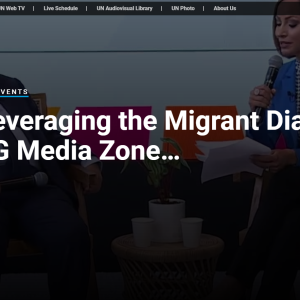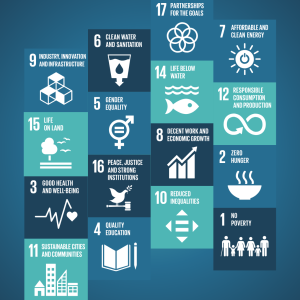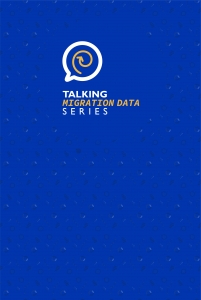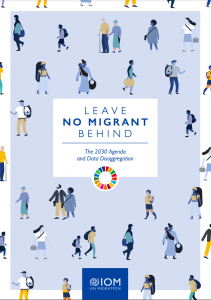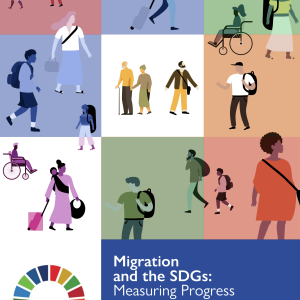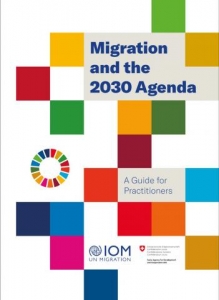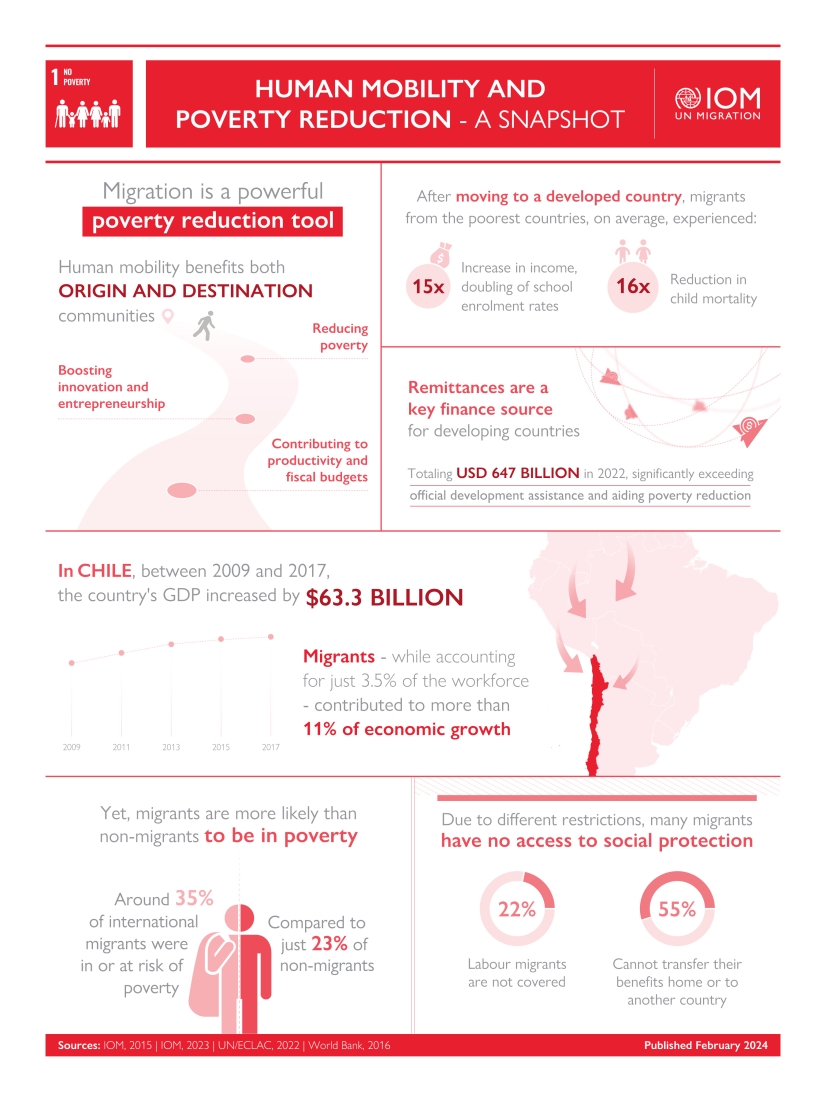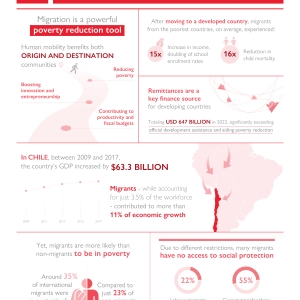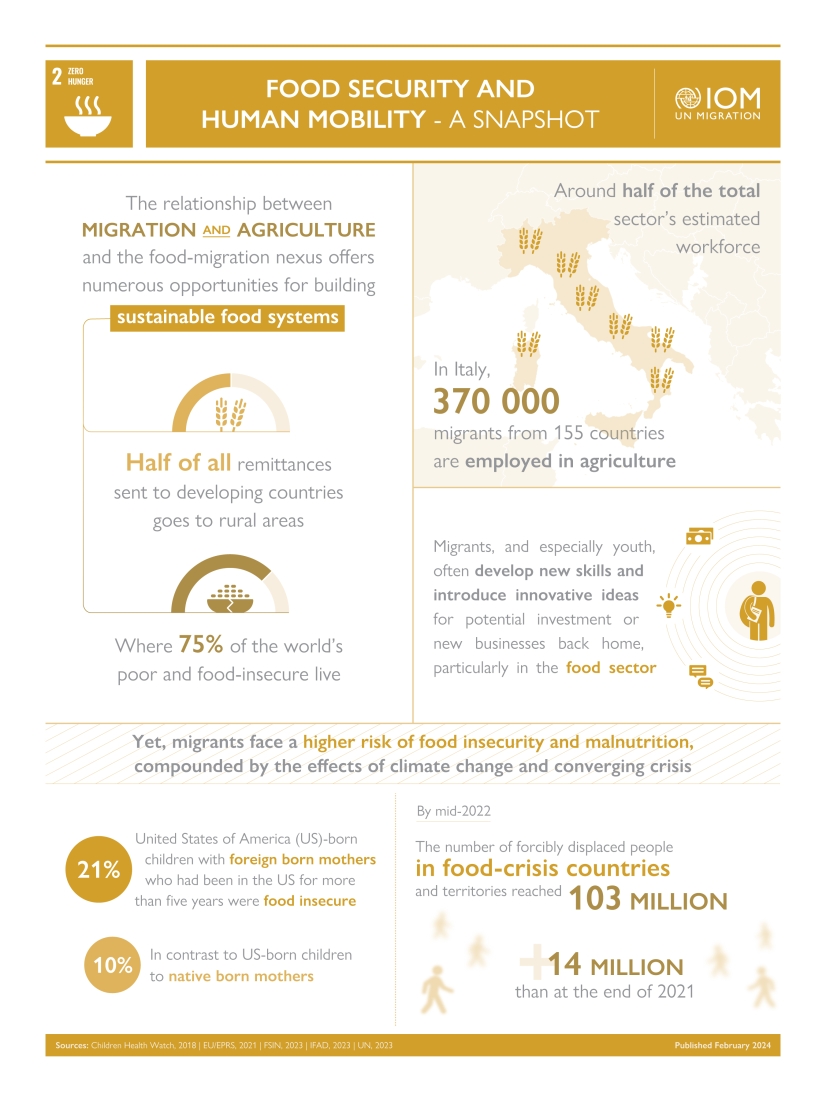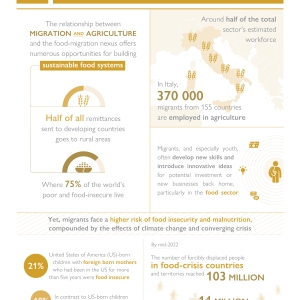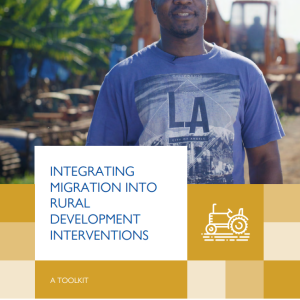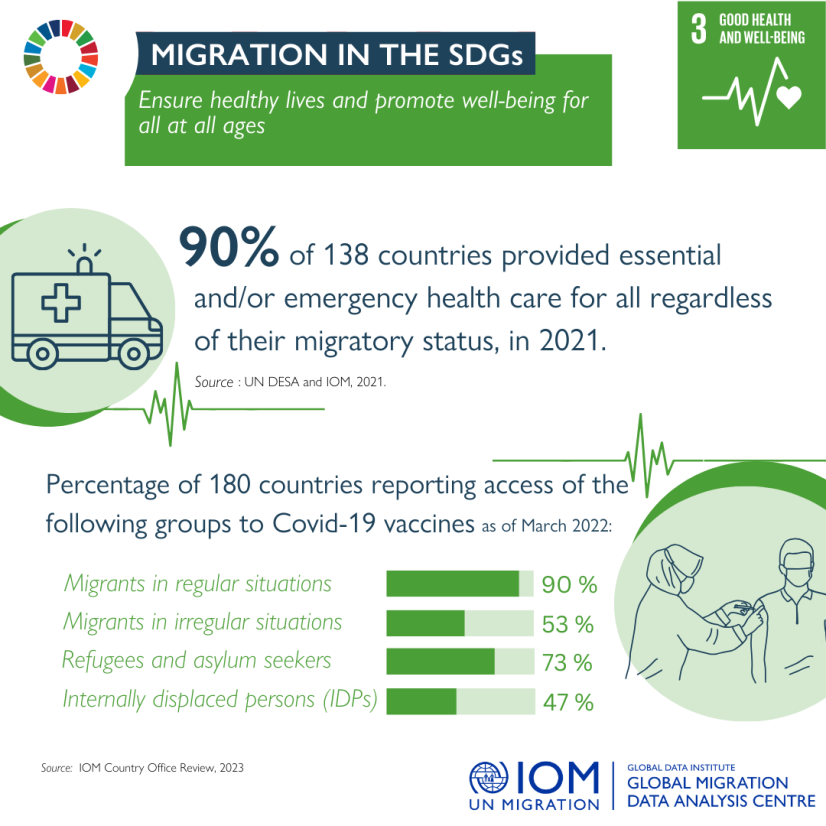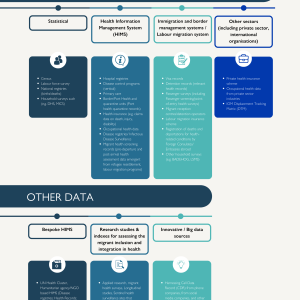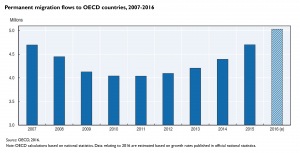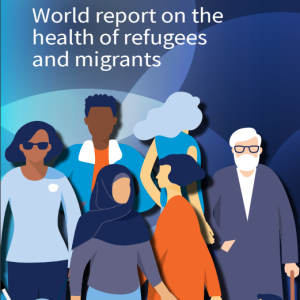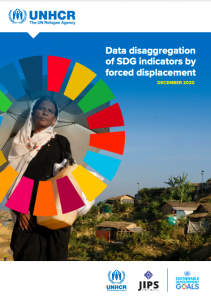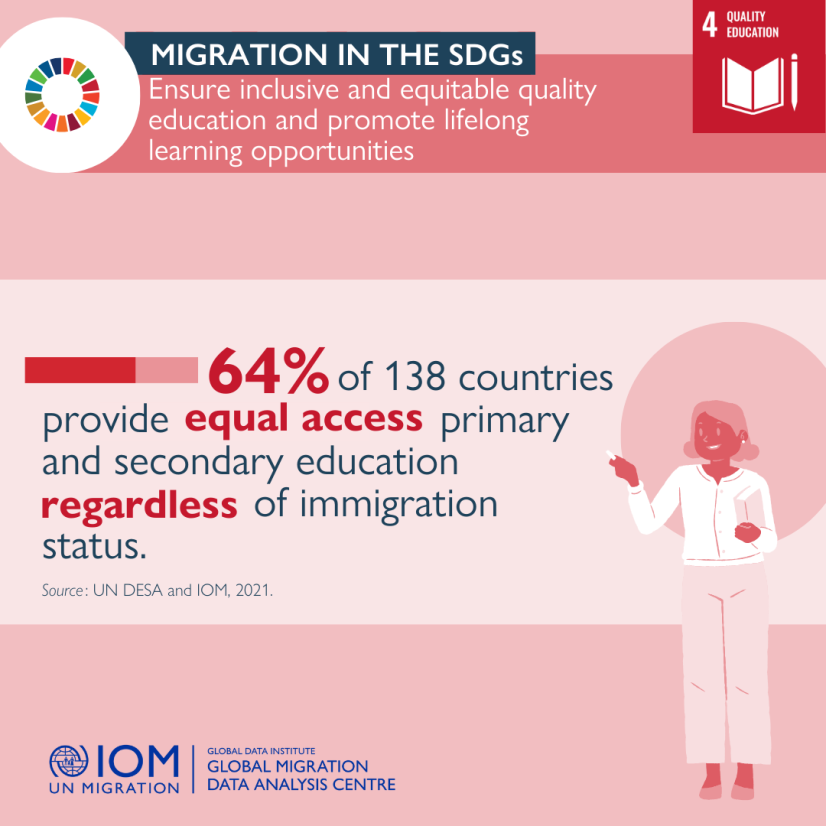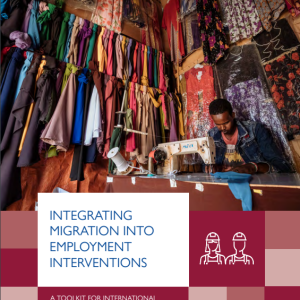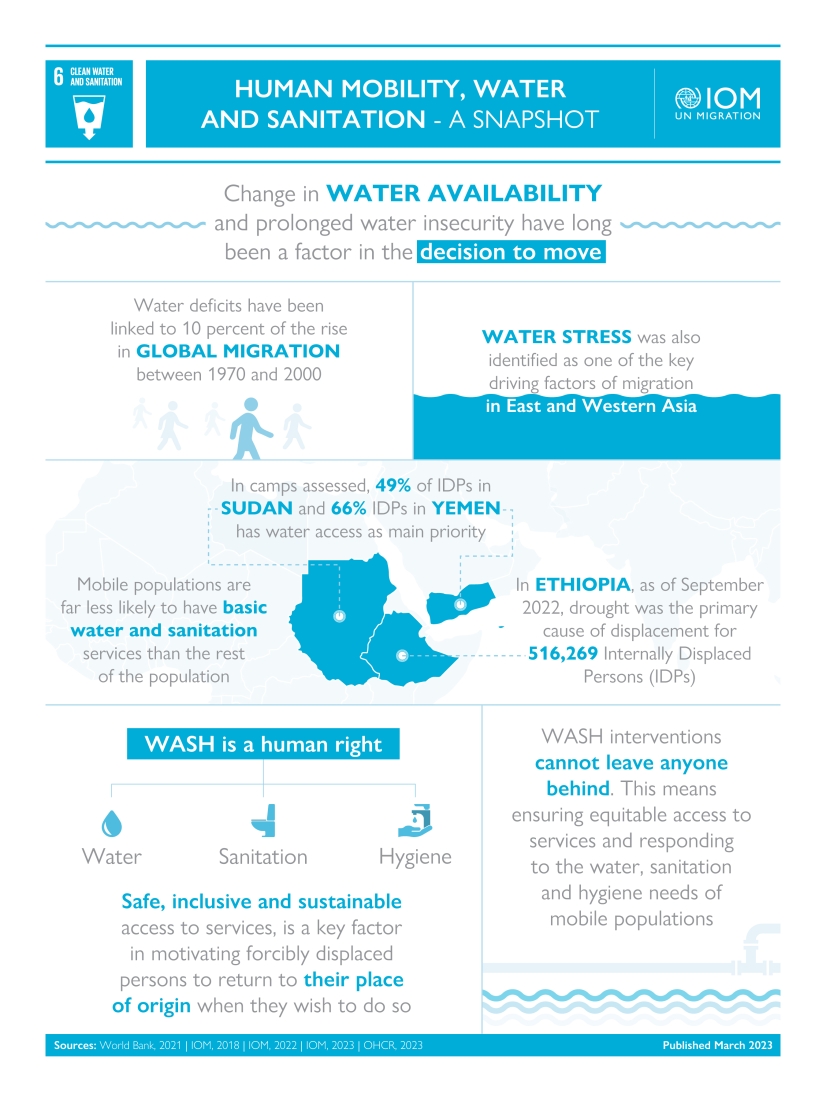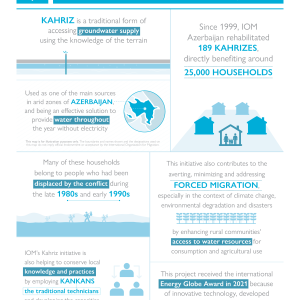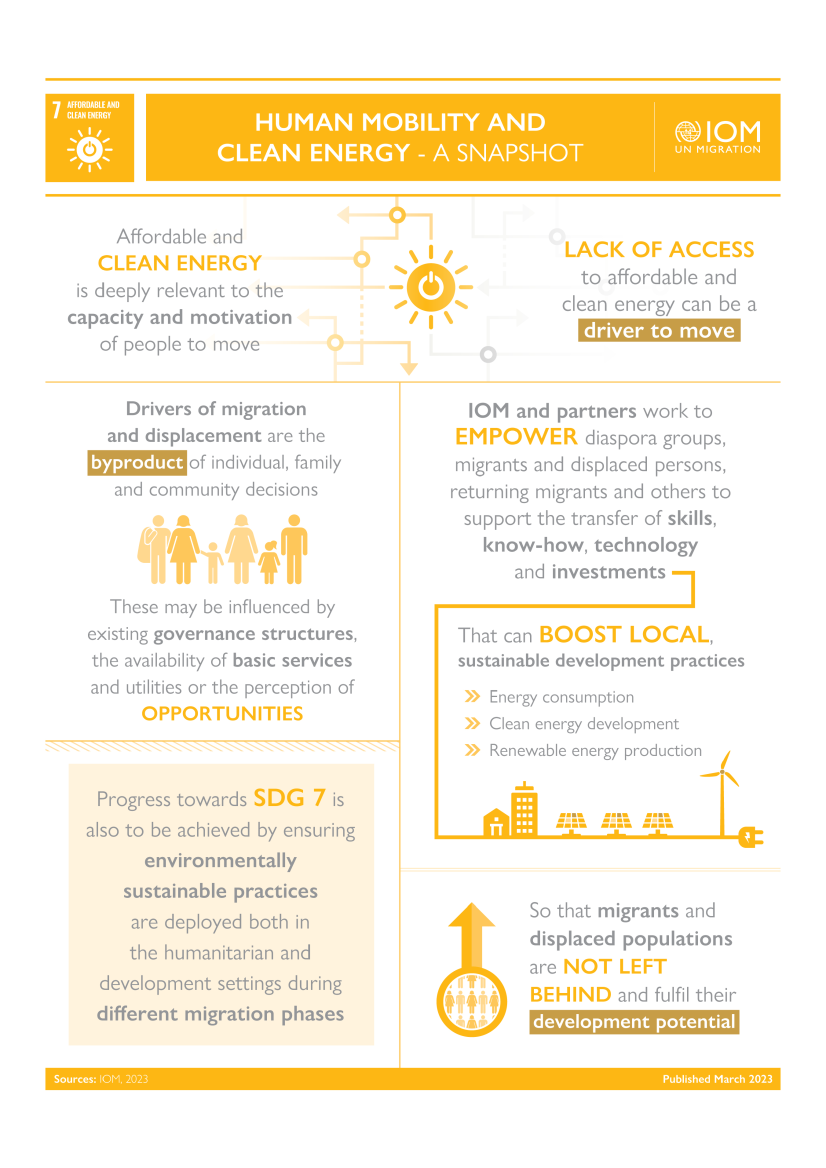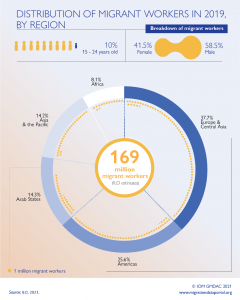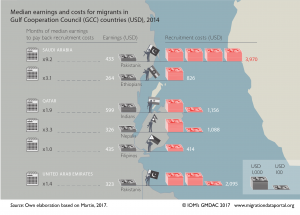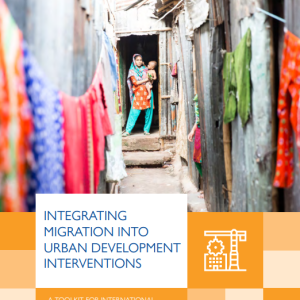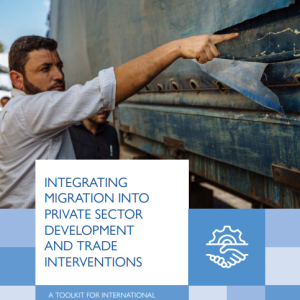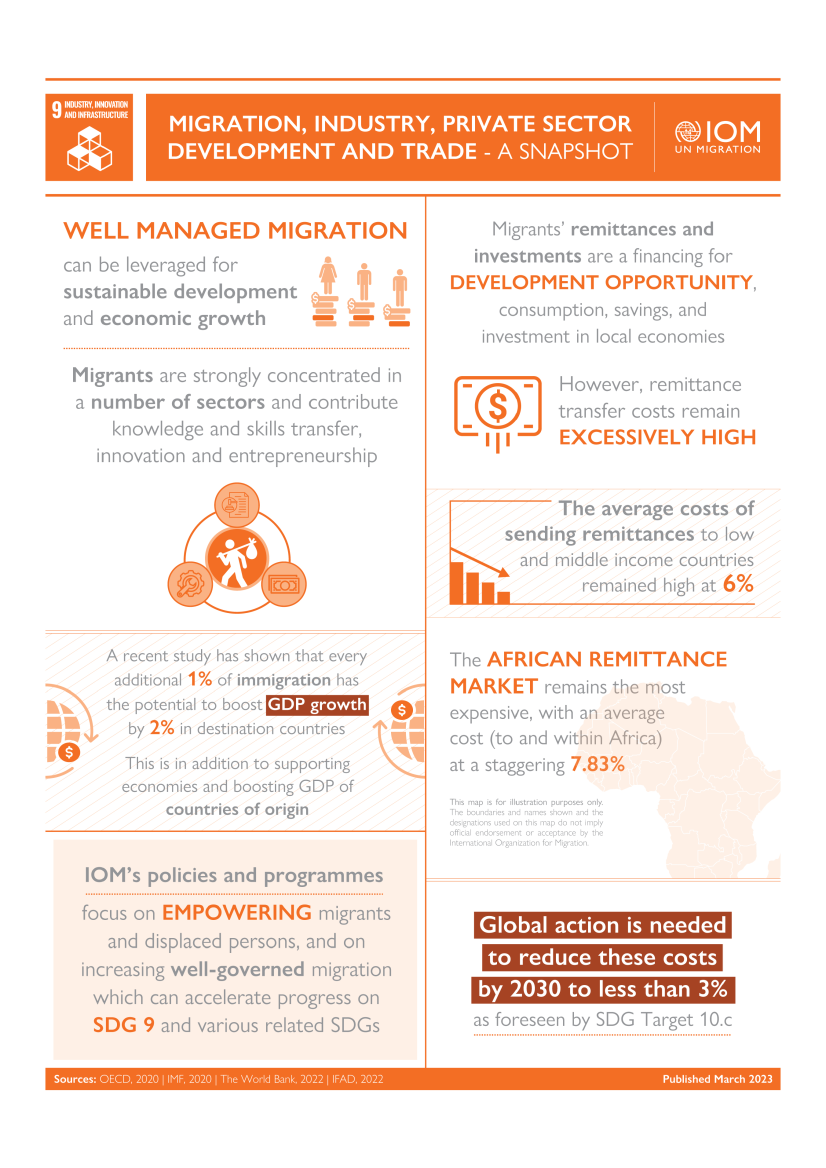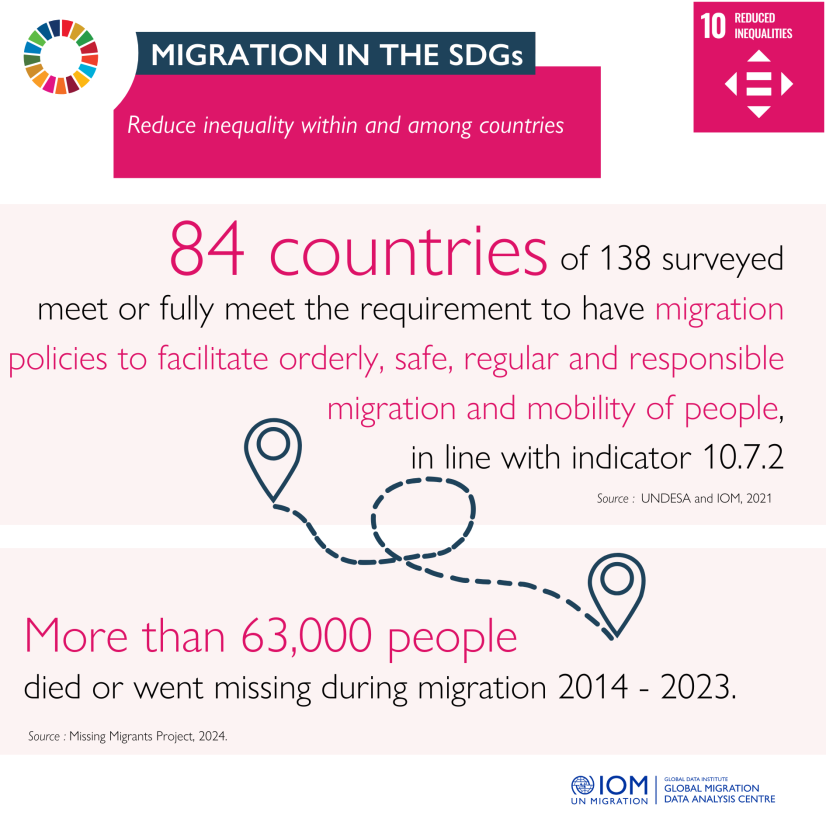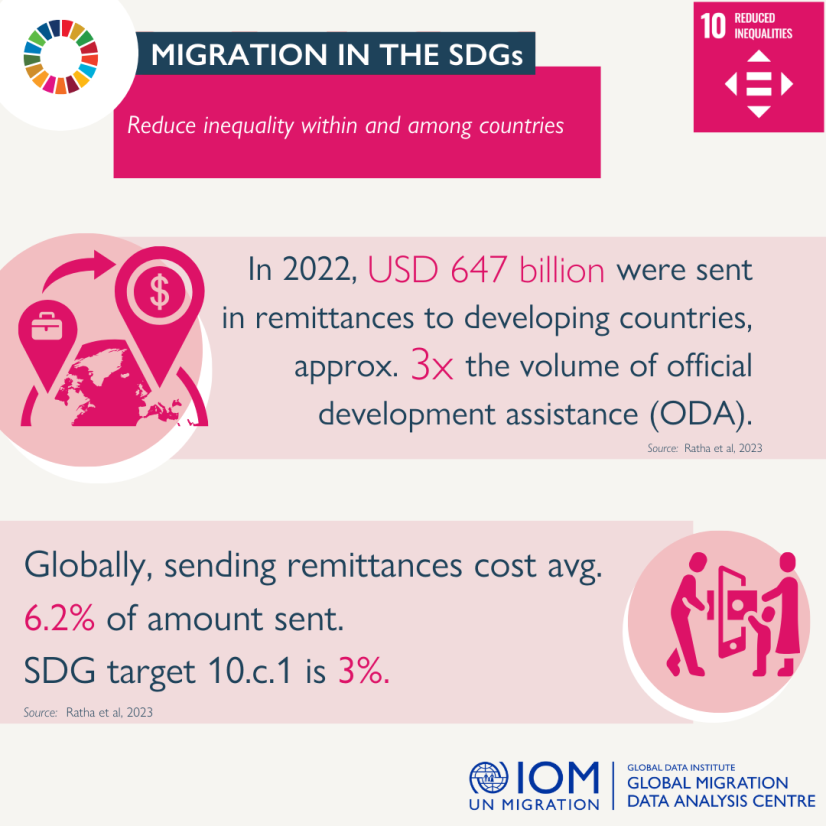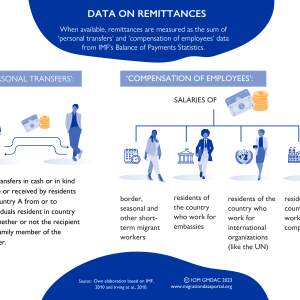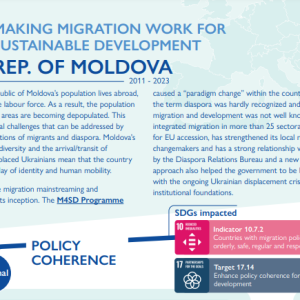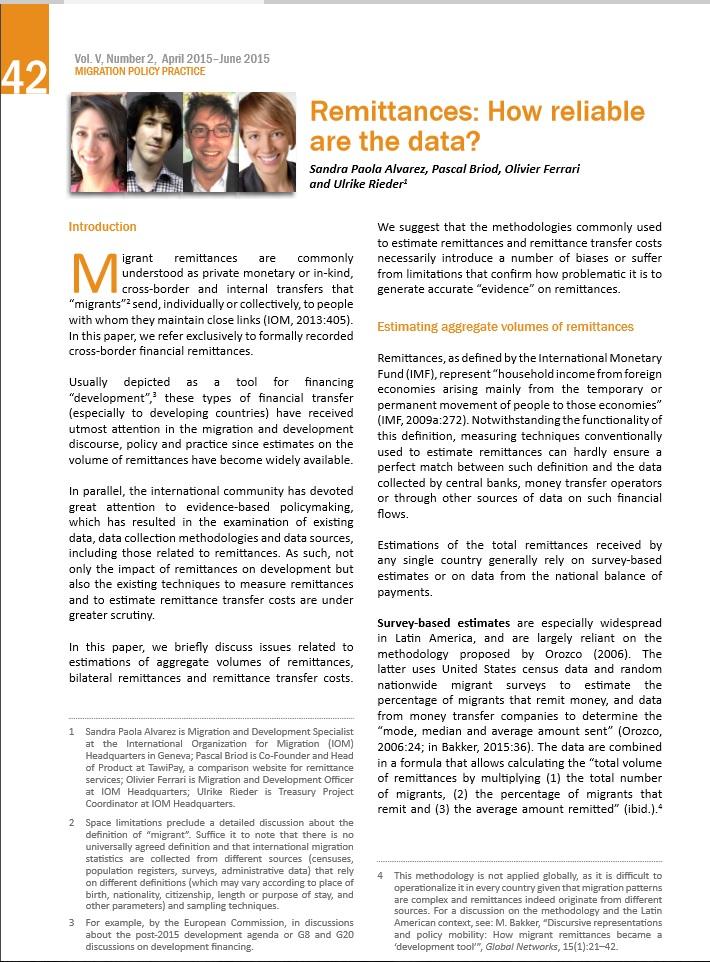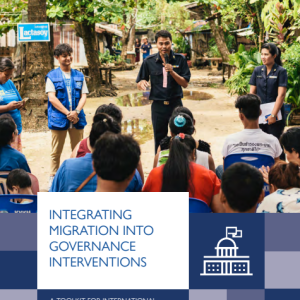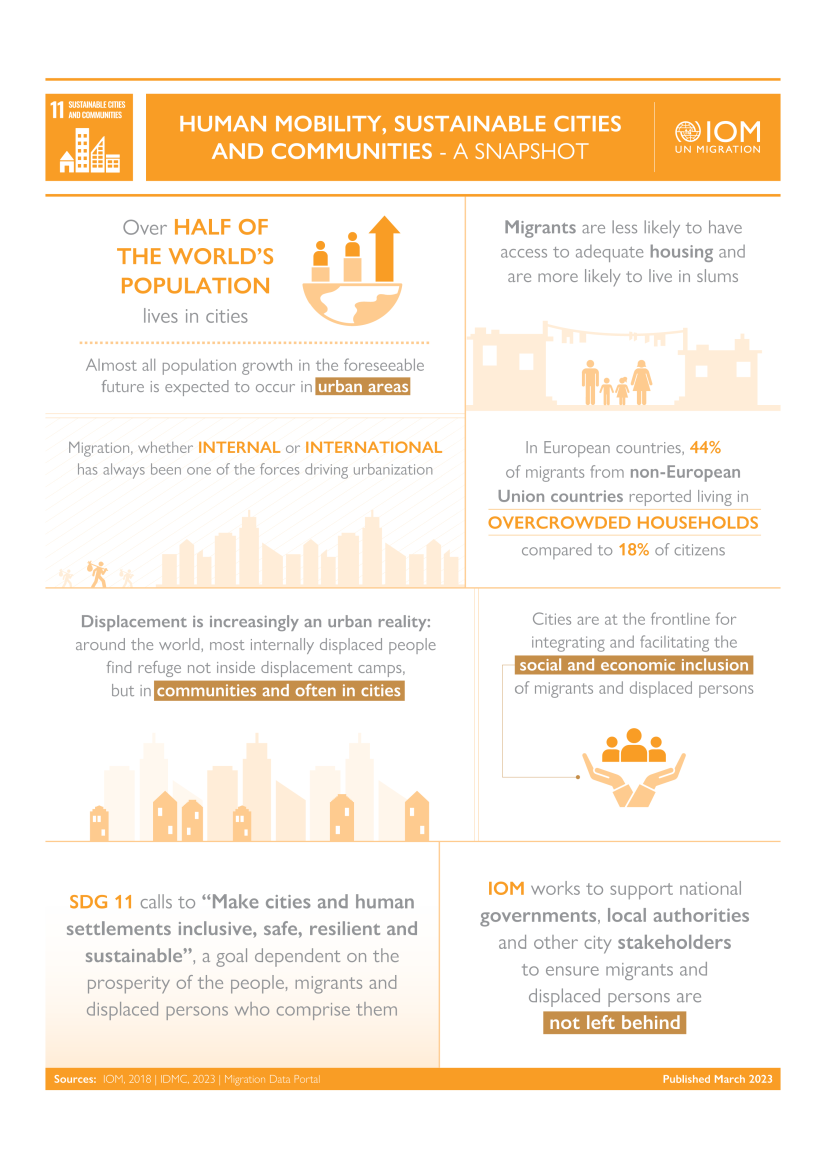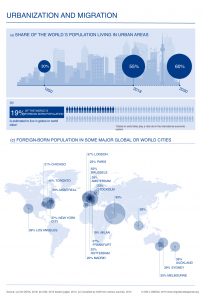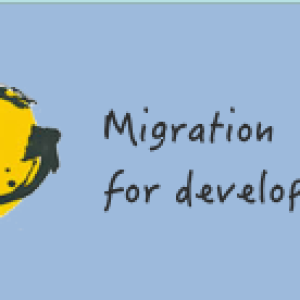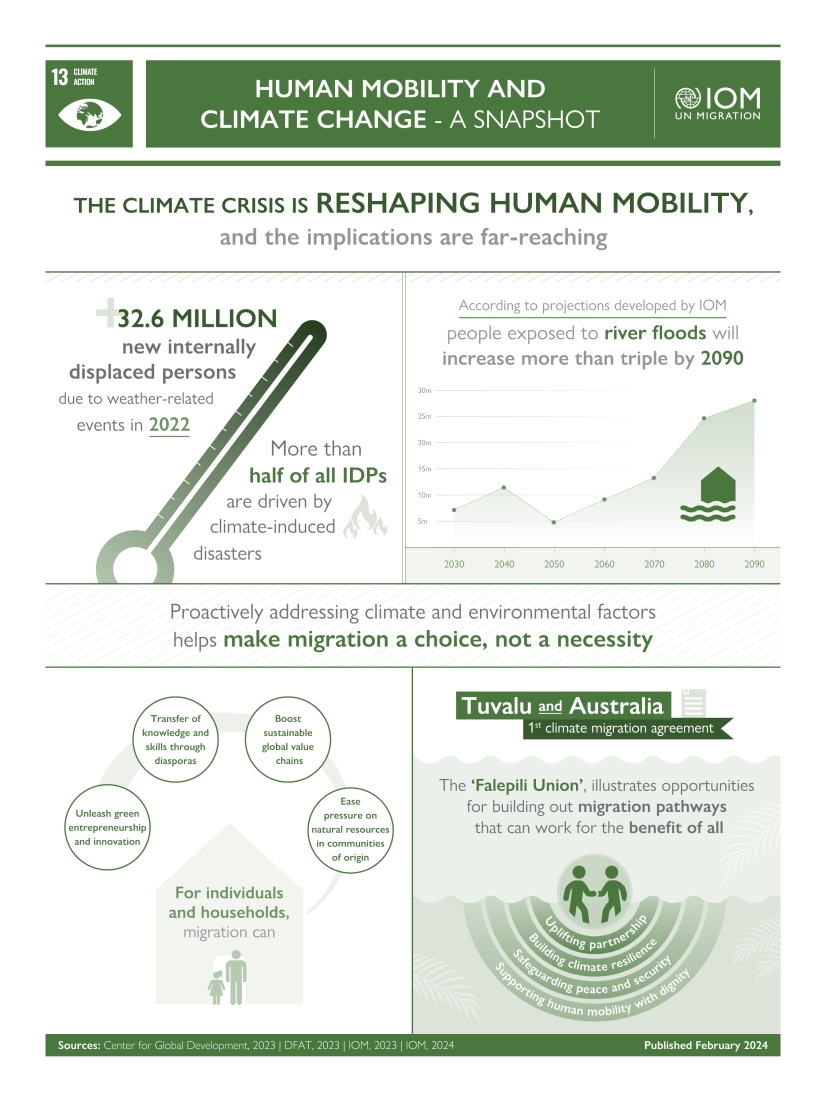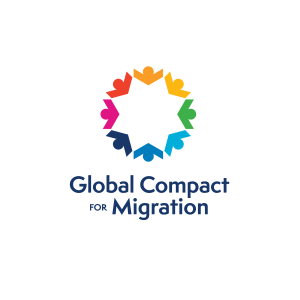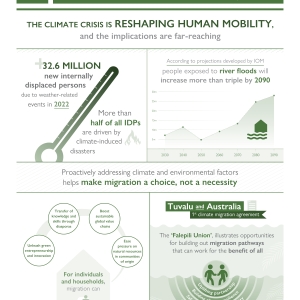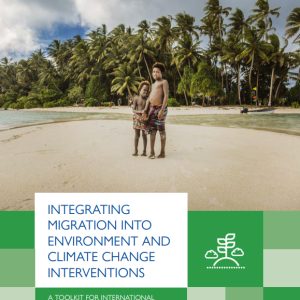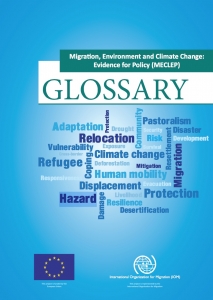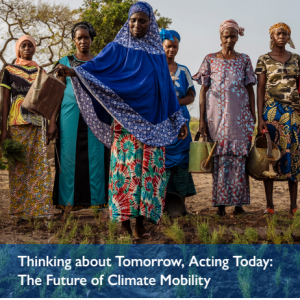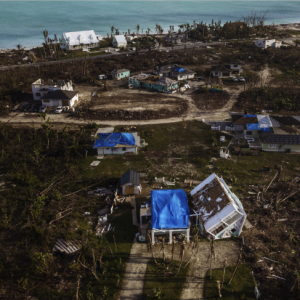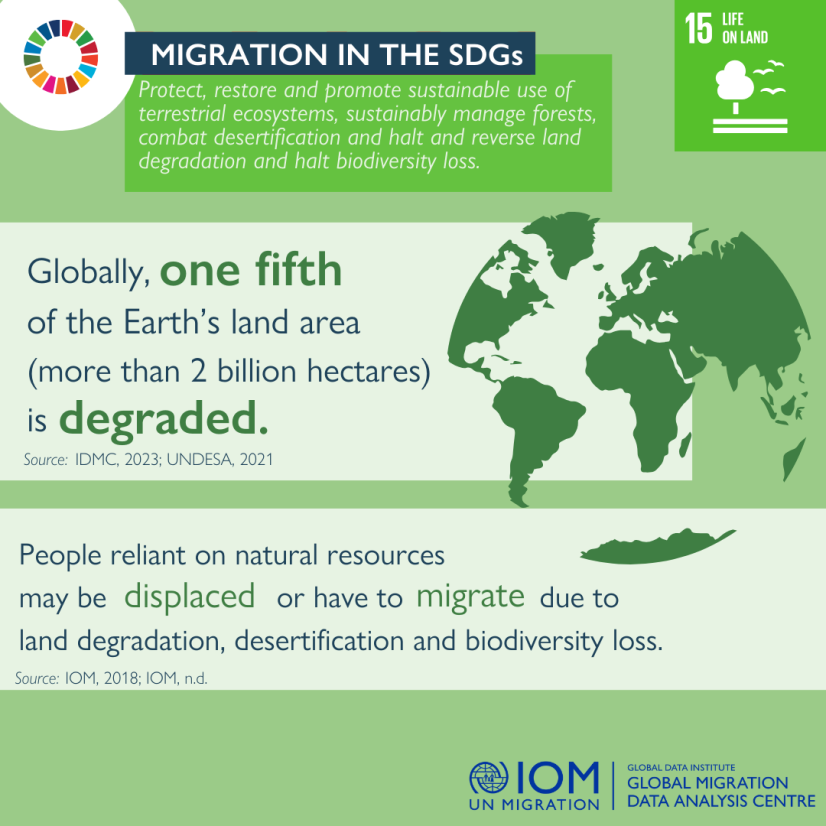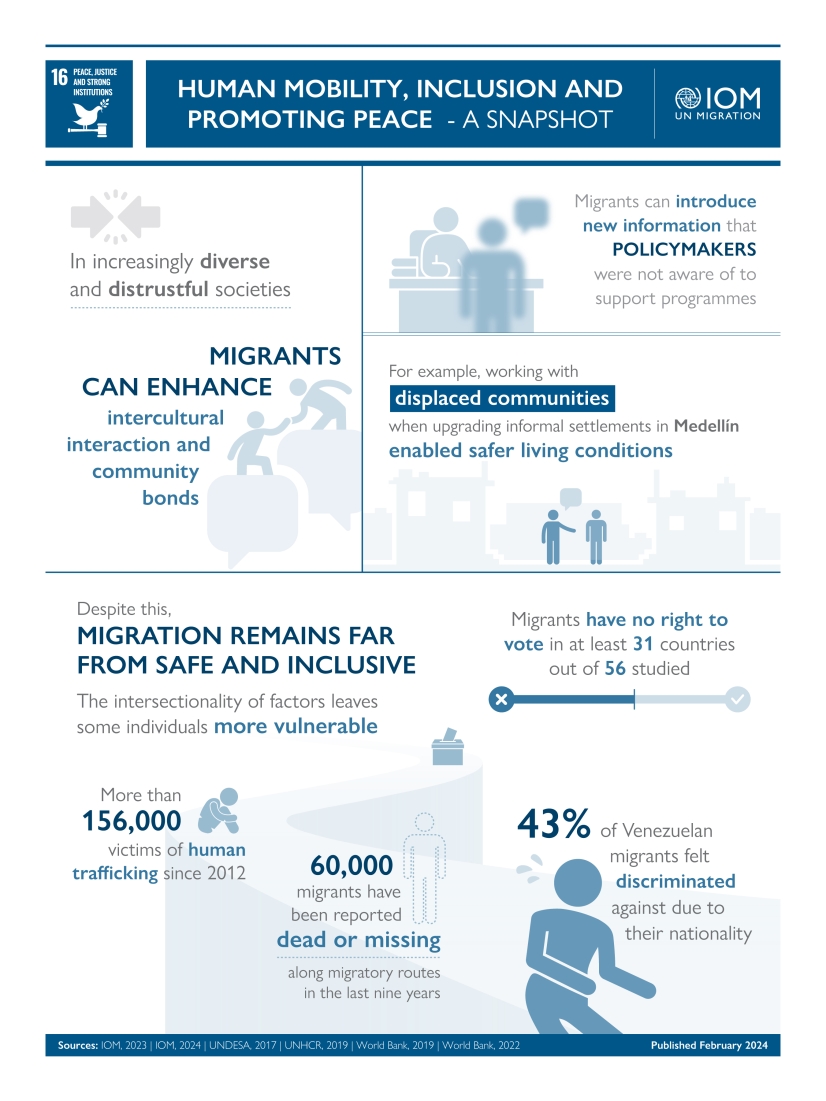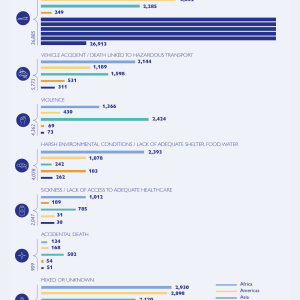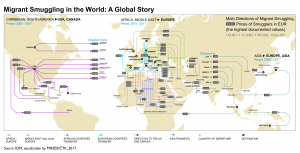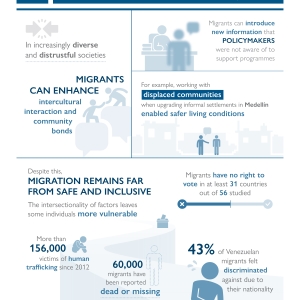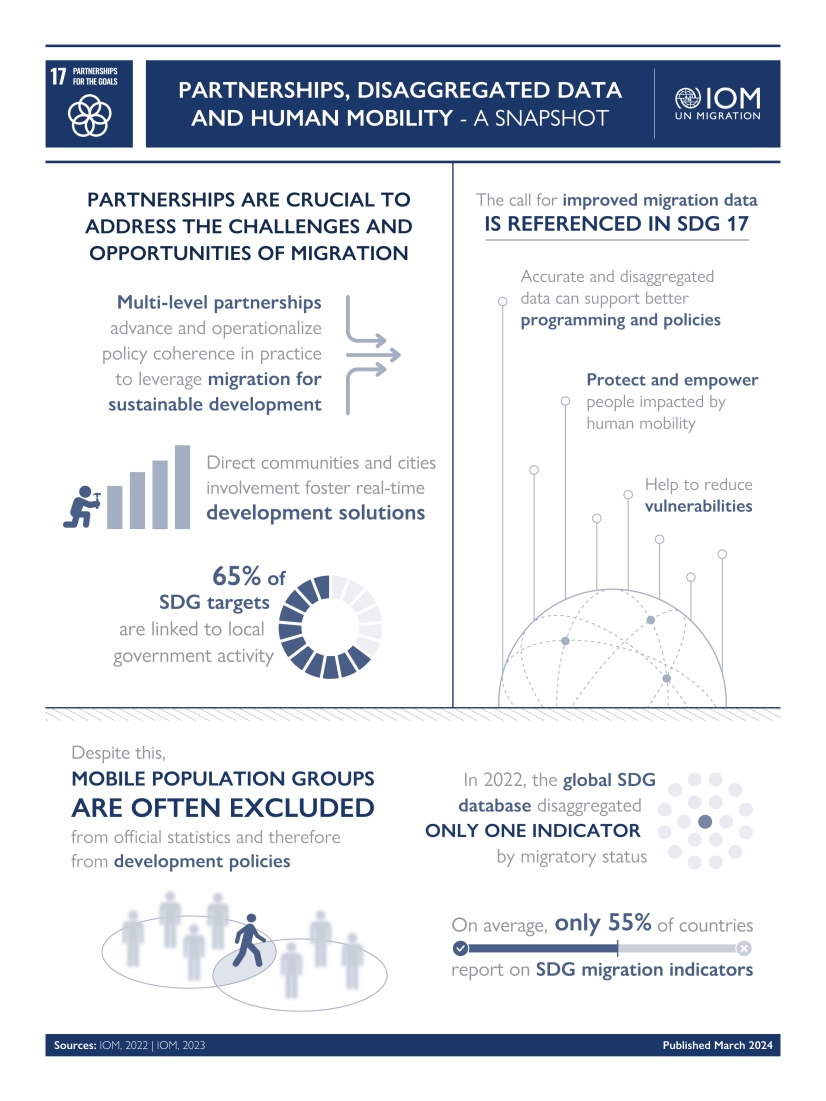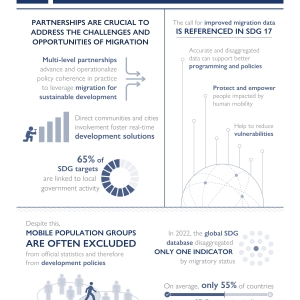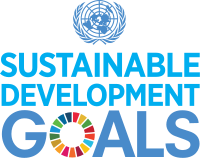
Migration Data and the Sustainable Development Goals (SDGs)
Spin the wheel to explore how each SDG relates to migration and learn more about migration-relevant data for each.
Introduction
The 2030 Agenda for Sustainable Development recognizes for the first time the contribution of migration to sustainable development. Migration is a cross-cutting issue in the 2030 Agenda, relevant to all of the Sustainable Development Goals (SDGs). Further, the SDG’s motto to “leave no one behind” is a clear call for sustainable development to be inclusive, including for migrants. At least ten out of 17 goals contain targets and indicators that are directly relevant to migration or mobility. The inclusion of migration in the 2030 Agenda presents countries with a series of new migration data challenges and reporting requirements. At the same time, this presents a crucial opportunity to improve migration data.
Migration in the SDGs
The SDGs’ central reference to migration is made in Target 10.7 to facilitate orderly, safe, regular and responsible migration and mobility of people, including through the implementation of planned and well-managed migration policies, which is in Goal 10 to reduce inequality within and among countries. Some other targets also make direct connections to migration topics, including labour migration (8.7 and 8.8), international student mobility (4.b), human trafficking (5.2, 8.7 and 16.2), remittances (10.c), migration data (17.18) and more.
Migration is also a cross-cutting issue across the 2030 Agenda, relevant to all 17 of the SDGs. This section goes beyond the direct references to migration to acknowledge and address the mutually supporting relationships between migration and each of the Goals and targets.
Migration in the SDG reporting framework
The 2030 Agenda includes a multi-layered follow-up mechanism to review progress on meeting the SDGs by 2030. As the SDGs are a country-owned process, the responsibility of SDG reporting lies with national governments. National reviews are the linchpin of the follow-up and review of SDG implementation, with regional, global and thematic reviews conducted to complement the process.
To monitor SDG progress, the Inter-Agency and Expert Group on SDG Indicators (IAEG-SDGs) developed a list of 231 individual global indicators, including several that refer to migration. These indicators include 3.c.1, 4.b.1, 8.7.1, 8.8.1, 10.c.1, 16.2.2 and others.
Further, SDG target 17.18 calls for greater support to developing countries to increase the availability of “high-quality, timely and reliable data, disaggregated by income, gender, age, race, ethnicity, and migratory status”. This reflects a growing understanding that disaggregation of data is an important way to ensure inclusiveness and prevent discrimination for specific population sub-groups, including migrants, to ensure no one is left behind. Doing this is an opportunity to gain better data on migrants’ situations to understand better their living conditions, and how migration impacts on health, income, education and other areas. Disaggregation is necessary in order to integrate migration as a cross-cutting theme across other sectors.
Meeting reporting requirements for the Goals is challenging and can present a significant burden to governments, in particular to National Statistical Offices (NSOs). At the global level, most countries still do not report on migration-SDG indicators or disaggregate other indicators by migratory status. Meanwhile, at the national level many countries monitor migration-SDG indicators and disaggregate these in innovative ways, for example by using existing data. See here what South Africa and Switzerland are doing.
Capacity development to boost migration-SDG data
More action is needed to translate SDG data frameworks into results, improving migration data realities on the ground. There is a need for countries to develop their capacity to generate and report meaningful data on migration in the context of the SDGs. Efforts must focus both on generating data for migration-SDG indicators and disaggregation of other indicators, as well as boosting use of this data. Steps must be taken to improve abilities to collect and use data to help policy makers devise evidence-based policies to tackle migration aspects of the SDGs. Several countries already collect considerable amounts of migration data across various government branches, but lack the capacity to centralize, disaggregate and cross reference data collected and use this towards SDG reporting. Better data sharing within government would also improve policy coherence, which is a key condition to achieving the SDGs. More opportunities for peer-to-peer learning between countries on migration-SDG data would also enable countries to share lessons learned.
Overall, there is a need to improve migration data locally, nationally, regionally and internationally for SDG monitoring purposes. Improving migration data is a crucial step to improving migration governance, and the SDG framework can help kick-start efforts to do this.
Ongoing work to measure migration in the SDGs
IOM and UN DESA, with support from the OECD, developed a methodology to measure indicator 10.7.2: number of countries with migration policies to facilitate orderly, safe, regular and responsible migration (see also here). This indicator is based on an assessment of six policy domains found in the Migration Governance Framework. It is also inspired by IOM's work on the Migration Governance Indicators (MGI).
The MGI framework can also be used to inform SDG implementation. The MGI uses approximately 100 qualitative questions to measure performance across six domains, drawn from the Migration Governance Framework. It is an analysis tool that is not meant for ranking countries on their migration policies, but rather aims to offer insights on policy levers that countries can action to strengthen their migration governance, as well as identify best practices of future programming. The results of this assessment can be used by governments to support reporting on their progress in achieving Target 10.7, as well as other migration-related targets.
IOM Global Data Institute (GDI): Global Migration Data Analysis Centre (GMDAC)'s work on the SDGsGMDAC champions the collection, analysis and use of migration data towards international frameworks and processes, including the SDGs. Selected activities related to the 2030 Agenda include: • Developing methodologies and collecting data related to SDG 10, specializing in migration governance (Migration Governance Indicators project) and migrant deaths (Missing Migrants Project). IOM is sole custodian of indicator 10.7.3 and co-custodian of indicator 10.7.2. • “Leaving no migrant behind” project on improving disaggregation of SDG data by migratory status around the world. Specialised guidance developed and rolled out in pilot countries. • Capacity development for Member States and other actors on improving collection and use of migration-relevant SDG data. • Dedicated publications, for example an edited volume on migration and the 2030 Agenda featuring dozens of experts, and a report on using census data to measure migration-related SDG indicators. |
____________________________
[1] OECD (2017), Development Co-operation Report 2017: Data for Development, OECD Publishing, Paris.
IAEG-SDGs Tier Classification for Global SDG Indicators
To facilitate the implementation of the global indicator framework, all indicators are classified by the IAEG-SDGs into three tiers based on their level of methodological development and the availability of data at the global level, as follows:
Source: 2023, United Nations Statistical Commission, Inter-agency Expert Group on SDG Indicators Tier Classification for SDG indicators (31 March 2023) and 13th meeting of the IAEG SDGs in November 2022.
SDG 1: NO POVERTY
End poverty in all its forms everywhere
What do we know?
Source: IOM, 2024.
Migration-relevant SDG targets and indicators:
All indicators are classified by the IAEG-SDGs into three tiers based on their level of methodological development and the availability of data at global level, as outlined here:
Target 1.1: Eradicate extreme poverty
Indicator 1.1.1 - Proportion of population below the international poverty line, by sex, age, employment status and geographical location (urban/rural)
Migration relevance:
- Data can be disaggregated by migratory status.
- Integrating the rights and interests of migrant groups, including asylum seekers, refugees and IDPs, in local and national poverty reduction policies and programming.
- Recognizing and promoting linkages between migration and poverty reduction for migrants and families, for example through impacts on income, health and education, including through remittances, skills and knowledge transfer and more; addressing barriers that limit these impacts such as poor working conditions for migrant workers and high remittance transfer costs.
Custodian agency: World Bank
Data sources:
- The indicator can be disaggregated for migrants versus non-migrants, or population living in migrant households versus population living in non-migrant households.
- Data can be collected through household surveys that include questions on migratory status, e.g. MICS and DHS.
Existing, relevant, disaggregated datasets:
| Country/area | Dataset Indicator | Last updated | Dataset Link | Migration Disaggregation |
|---|---|---|---|---|
| Jamaica | Percent distribution of women age 15-49 years, migratory status and years since last migration, and by wealth index quintile |
2022 | MICS, UNICEF | by migratory status |
| Trinidad and Tobago | Percent distribution of women age 15-49, migratory status and years since last migration, and percent distribution of women who migrated, type and place of last residence and wealth index quintile |
2022 | MICS, UNICEF | by migratory status |
| Eswatini | Percent distribution of women and men age 15-49 years by sex, migratory status and years since last migration, and percent distribution of women and men who migrated, by sex, type and place of last residence and wealth index quintile |
2021-2022 | MICS, UNICEF | By migratory status |
| Viet Nam | Percent distribution of population age 15-49 years by sex, migratory status and years since last migration, and percent distribution of population who migrated, by sex, type and place of last residence and wealth index quintile |
2020-2021 | MICS, UNICEF | By migratory status |
| Malawi | Percent distribution of population age 15-49 years by sex, migratory status and years since last migration, and percent distribution of population who migrated, by sex, and wealth index quintile |
2019-2020 | MICS, UNICEF | By migratory status |
| Australia | Rates of poverty by country of birth (Australia, major English-speaking country, other country) | 2019 | Australian Council of Social Service | By country of birth (Australia, major English-speaking country, other country) |
| United States of America | People at risk of poverty by nativity (Native born and foreign born - naturalized citizen, not citizen) | 2021 | US census | Native born and foreign born - naturalized citizen, not citizen |
| Europe | People at risk of poverty or social exclusion by broad group of citizenship (population aged 18 or over) | 2021 | EUROSTAT | By citizenship grouping |
| See also: Tuvalu, Kosovo1, Turcs and Caicos, Bangladesh, Belarus, Chad (only available in French), Dominican Republic, Fiji, Honduras, Nepal, Nigeria, Sao Tome and Principe (only available in Portuguese), Samoa, Serbia, Thailand, Tonga, Turkmenistan, Zimbabwe. | ||||
1References to Kosovo shall be understood to be in the context of United Nations Security Council resolution 1244 (1999).
If you know of additional data we should include here, please contact the team.
Target 1.2: Reduce poverty by at least 50%
Indicator 1.2.1 - Proportion of population living below the national poverty line, by sex and age
Migration relevance:
- Data can be disaggregated by migratory status.
- Integrating the rights and interests of migrant groups, including asylum seekers, refugees and IDPs, in local and national poverty reduction policies and programming.
- Recognizing and promoting linkages between migration and poverty reduction for migrants and families, for example through impacts on income, health and education, including through remittances, skills and knowledge transfer and more; addressing barriers that limit these impacts such as poor working conditions for migrant workers and high remittance transfer costs.
Custodian agency: World Bank
Data sources:
- While different approaches may be used in different countries to calculate the rate, this is usually based on household surveys as for 1.1.1.
Existing, relevant, disaggregated datasets:
| Country/Area | Dataset Indicator | Last updated | Dataset Link | Migration disaggregation |
|---|---|---|---|---|
| Fiji | Percent distribution of population age 15-49 years by sex, migratory status and years since last migration, and percent distribution of population who migrated, by sex, by type and place of last residence, and wealth index quintile | 2021 | MICS, UNICEF | By migratory status |
| Nigeria | Percent distribution of population age 15-49 years by sex, migratory status and years since last migration, and percent distribution of population who migrated, by sex, by type and place of last residence, and wealth index quintile | 2021 | MICS, UNICEF | By migratory status |
| Kosovo1 | Percent distribution of population age 15-49 years by sex, migratory status and years since last migration, and percent distribution of population who migrated, by sex, by type and place of last residence, and wealth index quintile | 2019-2020 | MICS, UNICEF | By migratory status |
| Switzerland | Poverty rate, by migration status, various socio-demographic characteristics and major regions (only available in German and French) | 2021 | Federal Statistical Office | By migration status |
| OECD and EU | Relative poverty rates, 16-year-olds and above | 2020 | OECD and EU |
Foreign born, Native born |
| See also: Tuvalu, Turcs and Caicos, Bangladesh, Belarus, Chad (only available in French), Dominican Republic, Honduras, Malawi, Nepal, Sao Tome and Principe (only available in Portuguese), Samoa, Serbia, Thailand, Tonga, Turkmenistan, Viet Nam, Zimbabwe. | ||||
If you know of additional data we should include here, please contact the team.
Indicator 1.2.2 - Proportion of men, women and children of all ages living in poverty in all its dimensions according to national definitions
Migration relevance:
- Data can be disaggregated by migratory status.
- Integrating the rights and interests of migrant groups, including asylum seekers, refugees and IDPs, in local and national poverty reduction policies and programming.
- Recognizing and promoting linkages between migration and poverty reduction for migrants and families, for example through impacts on income, health and education, including through remittances, skills and knowledge transfer and more; addressing barriers that limit these impacts such as poor working conditions for migrant workers and high remittance transfer costs.
Custodian agency: National gov.
Data sources:
- Methodologies vary though estimates are usually derived from household survey data
If you know of data we should include here, please contact the team.
Target 1.3: Implement social protection systems
Indicator 1.3.1 - Proportion of population covered by social protection floors/systems, by sex, distinguishing children, unemployed persons, older persons, persons with disabilities, pregnant women, newborns, work-injury victims and the poor and the vulnerable.
Migration relevance and rationale:
- Data can be disaggregated by migratory status.
- Social protection floors are nationally defined sets of basic social security guarantees that should ensure, as a minimum, that over the life cycle, all those in need have access to essential health care and basic income security which together secure effective access to goods and services defined as necessary at the national level (ILO social protection floors recommendation #202).
Custodian agency: ILO
Data sources:
- The ILO collects data on: (1) people covered by social protection floors/total population; (2) unemployed receiving unemployment benefit/total unemployment (3) employed women covered by maternity benefits/total female employment (4) people above the statutory pensionable age receiving an old-age pension/ people above the statutory pensionable age.
- It is possible to use household survey data, administrative records can also be used, including registration/membership of relevant schemes and tax or social security agency records and claims from national ministries of labour, social security, and other areas of government. If possible, information on eligibility, coverage and access to social protection in both destination and origin countries should be collected. Migrants may enjoy portability of benefits from origin countries, so if possible, data should be collected on whether migrants are claiming any benefits offered by origin-country governments for citizens abroad.
If you know of data we should include here, please contact the team.
Target 1.4: Equal rights to ownership, basic services, technology and economic resources
Indicator 1.4.1 - Proportion of population living in households with access to basic services
Migration relevance:
- Data can be disaggregated by migratory status.
- Addressing inequalities in basic services, ownership and control over land and other forms of property, to uphold human rights of migrants, ensure migrants can contribute to social and economic development in host communities, and to address these insofar as they can be potential drivers of migration. Increasing access to economic resources, basic services, ownership and control over land and other forms of property for migrants. Strengthening mechanisms by which migration can increase rights and access to economic resources, basic services and land/property ownership and control to families and communities.
Custodian agency: UN-Habitat
Data sources:
- Possible data sources include household surveys (e.g. DHS, MICS and Living Standards Measurement Study (LSMS)) and IPUMS-International census microdata.
If you know of data we should include here, please contact the team.
Target 1.5: Built resilience to environmental, economic and social disasters
Indicator 1.5.1 - Number of deaths, missing persons and directly affected persons attributed to disasters per 100,000 population
Migration relevance and rationale:
- Data can be disaggregated by migratory status.
- Addressing how climate-related events and other economic, social and environmental shocks and disasters forcibly displace people.
- Integrating migration and migrants in disaster risk reduction and management, post-disaster response and other humanitarian responses, according to the Migrants in Countries in Crisis (MICIC) guidelines.
- Strengthening adaptation strategies and other mechanisms by which people can protect themselves from extreme events which may cause displacement; recognizing migration as an adaptation strategy
Custodian agency: UNDRR
Data sources:
- National disaster databases, civil registration and vital statistics systems.
- Some data on migrants affected by disaster is available via forced displacement data insofar as they were forced to migrate.
Existing, relevant, disaggregated datasets:
| Country/area | Dataset indicator | Last updated | Dataset link | Migration disaggregation |
|---|---|---|---|---|
| Global | Number of internal displacements in 2022 due to disaster | 2023 | IDMC | Internal displacement |
| Global | Total number of internally displaced persons (IDPs) due to disasters, as of Dec 2022 | 2023 | IDMC | Internally displaced persons |
If you know of data we should include here, please contact the team.
Target 1.A: Mobilize resources to implement policies to end poverty
Indicator 1.a.1 - Total official development assistance grants from all donors that focus on poverty reduction as a share of the recipient country’s gross national income
Migration relevance and rationale:
- Promoting responsible and fair use of remittances, diaspora investment and other forms of migration-related financial flows to assist development and poverty eradication interventions.
Custodian agency: OECD
Data sources: tbc
If you know of data we should include here, please contact the team.
Target 1.B: Create pro-poor and gender-sensitive policy frameworks
Indicator 1.b.1 - Pro-poor public social spending
Migration relevance and rationale:
- Local, national, regional and international policy frameworks recognizing migration’s role in development and poverty eradication; mainstreaming migration into local or national development plans.
Custodian agency: UNICEF
Data sources: tbc
If you know of data we should include here, please contact the team.
Sources:
Mosler Vidal, E., 2021. Leave No Migrant Behind: The 2030 Agenda and Data Disaggregation. International Organization for Migration (IOM), Geneva.
IOM, 2018. Migration and the 2030 Agenda: Comprehensive SDG Target and Migration Correlation. International Organization for Migration (IOM), Geneva.
United Nations Statistics Division, Improving migration data in the context of the 2030 Agenda, 15 June 2017
The Global Goals: Resources
Tiers updated according to:
2023, United Nations Statistical Commission, Inter-agency Expert Group on SDG Indicators Tier Classification for SDG indicators (as of 31 March 2023)
Source: 2023, United Nations Statistical Commission, Inter-agency Expert Group on SDG Indicators Tier Classification for SDG indicators (31 March 2023) and 13th meeting of the IAEG SDGs in November 2022.
- 11 References to Kosovo shall be understood to be in the context of United Nations Security Council resolution 1244 (1999)
SDG 2: ZERO HUNGER
End hunger, achieve food security and improved nutrition and promote sustainable agriculture
What do we know?
Source: IOM, 2024.
Migration-relevant SDG targets and indicators:
All indicators are classified by the IAEG-SDGs into three tiers based on their level of methodological development and the availability of data at global level, as outlined here:
Target 2.1 Universal access to safe and nutritious food
Indicator 2.1.1 - Prevalence of undernourishment
Migration relevance and rationale:
- Data can be disaggregated by migratory status, however migrants are largely invisible in official data relating to the health SDGs because of the lack of disaggregated data within national health information system and other sources of health data from surveys, disease control programs, registries etc. It is, therefore, hard to understand and address the needs of refugees and migrants, develop inclusive public health approaches and track progress towards national and global goals.
Custodian agency: FAO
Data sources:
- Household surveys are the most common sources for undernourishment data (e.g. DHS, MICS and LSMS).
If you know of data we should include here, please contact the team.
Indicator 2.1.2 - Prevalence of moderate or severe food insecurity in the population, based on the Food Insecurity Experience Scale
Migration relevance and rationale:
- Data can be disaggregated by migratory status, however migrants are largely invisible in official data relating to the health SDGs because of the lack of disaggregated data within national health information system and other sources of health data from surveys, disease control programs, registries etc. It is, therefore, hard to understand and address the needs of refugees and migrants, develop inclusive public health approaches and track progress towards national and global goals.
Custodian agency: FAO
Data sources:
- MICS surveys and experience-based food security scale questionnaires used in household surveys.
If you know of data we should include here, please contact the team.
Target 2.2 End all forms of malnutrition
Indicator 2.2.1 - Prevalence of stunting (height for age < -2 standard deviation from the median of the World Health Organization (WHO) Child Growth Standards) among children under 5 years of age.
Migration relevance and rationale:
- Data can be disaggregated by migratory status, however migrants are largely invisible in official data relating to the health SDGs because of the lack of disaggregated data within national health information system and other sources of health data from surveys, disease control programs, registries etc. It is, therefore, hard to understand and address the needs of refugees and migrants, develop inclusive public health approaches and track progress towards national and global goals.
Data sources:
- MICS surveys and household surveys.
- Note: Wasting is an acute condition that can change frequently and very rapidly. This makes reliable data collection on this over time difficult, as data can only ever record a snapshot in time. This may be especially relevant when collecting data on forcibly displaced or certain hard-to-reach populations.
If you know of data we should include here, please contact the team.
Indicator 2.2.2 - Prevalence of malnutrition (weight for height > +2 or < -2 standard deviation from the median of the WHO Child Growth Standards) among children under 5 years of age, by type (wasting and overweight)
Migration relevance and rationale:
- Data can be disaggregated by migratory status, however migrants are largely invisible in official data relating to the health SDGs because of the lack of disaggregated data within national health information system and other sources of health data from surveys, disease control programs, registries etc. It is, therefore, hard to understand and address the needs of refugees and migrants, develop inclusive public health approaches and track progress towards national and global goals.
Data sources:
- MICS surveys and household surveys.
If you know of data we should include here, please contact the team.
Target 2.3 Double the productivity and incomes of small-scale food producers
Indicator 2.3.2 - Average income of small-scale food producers, by sex and indigenous status
Migration relevance and rationale:
- Increasing income and productivity of small scale food producers, insofar as they can be potential drivers of migration
Custodian agency: FAO
Data sources:
- Possible data sources include household surveys and IPUMS-International census microdata insofar as they capture relevant data on food producers.
- Note: Target 2.3 requires a specific focus on indigenous peoples, and relevant disaggregation is recommended.
If you know of data we should include here, please contact the team.
Target 2.4 Sustainable food production and resilient agricultural practices
Migration relevance and rationale: See Food security and human mobility.
Data sources: tbc
If you know of data we should include here, please contact the team.
Sources:
Mosler Vidal, E., 2021. Leave No Migrant Behind: The 2030 Agenda and Data Disaggregation. International Organization for Migration (IOM), Geneva.
IOM, 2018. Migration and the 2030 Agenda: Comprehensive SDG Target and Migration Correlation. International Organization for Migration (IOM), Geneva.
United Nations Statistics Division, Improving migration data in the context of the 2030 Agenda, 15 June 2017
The Global Goals: Resources
Tiers updated according to:
2023, United Nations Statistical Commission, Inter-agency Expert Group on SDG Indicators Tier Classification for SDG indicators (as of 31 March 2023)
IAEG-SDGs Tier Classification for Global SDG Indicators
Tier 1:Indicator is conceptually clear, has an internationally established methodology and standards are available, and data are regularly produced by countries for at least 50 per cent of countries and of the population in every region where the indicator is relevant.
Source: 2023, United Nations Statistical Commission, Inter-agency Expert Group on SDG Indicators Tier Classification for SDG indicators (31 March 2023) and 13th meeting of the IAEG SDGs in November 2022.
SDG 3: GOOD HEALTH AND WELL-BEING
Ensure healthy lives and promote well-being for all
What do we know?
Migration-relevant SDG targets and indicators:
All indicators are classified by the IAEG-SDGs into three tiers based on their level of methodological development and the availability of data at global level, as outlined here:
Target 3.1: Reduce maternal mortality
Indicator 3.1.1 - Maternal mortality ratio
Migration relevance:
- Data can be disaggregated by migratory status.
- Addressing the vulnerability of migrant mothers and pregnant migrants in all countries and communities, including in refugee camps, makeshift settlements and IDP settlements, to increase access maternal health-care services (obstetric, antenatal and postnatal care) and decrease maternal mortality and morbidity. Migrants tend to have higher maternal mortality due to lack of access to proper maternal and child care. This is an outcome variable measuring migrants' access to health services.
Custodian agency: WHO
Data sources:
- Most data are collected through vital registration systems, which may already collect information on country of birth/citizenship of the deceased. Alternatively, IPUMS International census microdata or administrative records can be used. Household surveys may also be used, such as MICS.
- Note: as maternal mortality is relatively rare, large sample sizes would be needed to make these nationally representative if disaggregated by migratory status. It may be challenging to record migrant maternal mortality on migratory routes or for newly arrived migrants, as this requires strong continuity of health care.
If you know of data we should include here, please contact the team.
Indicator: 3.1.2 - Proportion of births attended by skilled health personnel
Migration relevance:
- Data can be disaggregated by migratory status.
- Addressing the vulnerability of migrant mothers and pregnant migrants in all countries and communities, including in refugee camps, makeshift settlements and IDP settlements, to increase access maternal health-care services (obstetric, antenatal and postnatal care) and decrease maternal mortality and morbidity.
Data sources:
- Common data sources include household surveys such as DHS, MICS or reproductive health surveys (RHS).
If you know of data we should include here, please contact the team.
Target 3.2: End all preventable deaths under 5 years of age
Indicator 3.2.1 - Under-five mortality rate
Migration relevance:
- Data can be disaggregated by migratory status.
- Addressing the vulnerability of migrant newborns and children under 5 years of age in all countries, including in refugee camps, makeshift settlements and IDP settlements, to increase their access to health-care services and decrease mortality and morbidity. This SDG Indicator can reflect to what extent migrants have access to health services.
Data sources:
- Mainly derived from civil registration, where death registrations should record information on migratory status of the mother and child. Data from censuses (including IPUMS-International microdata) and household surveys may also be used.
Custodian agency: UNICEF
Existing, relevant, disaggregated data sources:
| Country/Area | Dataset indicator | Last updated | Link to dataset | Migration disaggregation |
|---|---|---|---|---|
| Qatar | Infant mortality rate by nationality and gender (2008-2018) | 2018 | Planning and Statistics Authority of Qatar | By nationality |
If you know of data we should include here, please contact the team.
Indicator 3.2.2 - Neonatal mortality rate
Migration relevance:
- Data can be disaggregated by migratory status.
- Addressing the vulnerability of migrant newborns in all countries, including in refugee camps, makeshift settlements and IDP settlements, to increase their access to health-care services and decrease mortality and morbidity.
- This SDG Indicator can reflect to what extent migrants have access to health services.
Custodian agency: WHO
Data sources:
- Data is mainly derived from civil registration, where death registrations should record information on migratory status of the mother and child.
- Data from censuses (including IPUMS-International microdata) and household surveys may also be used.
If you know of data we should include here, please contact the team.
Target 3.3: Fight communicable diseases
Indicator 3.3.1 - Number of new HIV infections per 1,000 uninfected population, by sex, age and key populations
Migration relevance and rationale:
- Data can be disaggregated by migratory status.
- This indicator reflects how migrants have access to HIV treatment and antiretroviral therapy (ART), can address epidemiological vulnerability of migrants in all countries and their settlements, and integrate the health needs of migrants in health policy and programming for HIV.
Custodian agency: WHO
Data sources:
- Common data sources include household or other surveys with HIV incidence testing (including at focused antenatal clinics (FANC) where expectant mothers are tested) and countries’ regular surveillance systems among key populations if they have them, including a range of health-related administrative records.
- Note: As new infection rates can be low in some countries, large sample sizes would be needed for surveys to be nationally representative if disaggregated by migratory status.
If you know of data we should include here, please contact the team.
Indicator 3.3.2 - Tuberculosis incidence per 1,000 population
Migration relevance:
- Data can be disaggregated by migratory status.
- This indicator reflects how migrants have access to healthcare services, and can address epidemiological vulnerability of migrants in all countries and their settlements, and integrate the health needs of migrants in health policy and programming for tuberculosis.
Custodian agency: WHO
Data sources:
- Possible data sources include countries’ surveillance systems or other ways to show annual case notifications, surveys of tuberculosis prevalence, or death (vital) registration systems.
- Note: few national disease control programmes such as those on tuberculosis capture data by migratory status. Countries that have reached elimination phases and with cross-border regions with high disease burden are more likely to have regular data capture; however, these are ad hoc and not always integrated into the HMIS (WHO, 2017). As incidence can be low in some countries, large sample sizes would be needed for surveys to be nationally representative if disaggregated by migratory status.
If you know of data we should include here, please contact the team.
Indicator 3.3.3 - Malaria incidence per 1,000 population
Migration relevance and rationale:
- Data can be disaggregated by migratory status.
- This indicator reflects how migrants have access to healthcare services, and can address epidemiological vulnerability of migrants in all countries and their settlements, and integrate the health needs of migrants in health policy and programming for malaria.
Custodian agency: WHO
Data sources:
- Common data sources include countries’ surveillance systems or other ways to show numbers of positive, suspected and/or tested cases.
- Surveys such as DHS or the Malaria Indicator Survey (MIS) can also be used.
- Note: As incidence can be low in some countries, large sample sizes would be needed for surveys to be nationally representative if disaggregated by migratory status.
If you know of data we should include here, please contact the team.
Indicator 3.3.4 - Hepatitis B incidence per 100,000 population
Migration relevance and rationale:
- Data can be disaggregated by migratory status.
- This indicator reflects how migrants have access to healthcare services, and can address epidemiological vulnerability of migrants in all countries and their settlements, and integrate the health needs of migrants in health policy and programming to combat hepatitis.
Custodian agency: WHO
Data sources:
- Common data sources include countries’ surveillance systems or other ways to calculate country estimates – for example, from serosurveys.
- Surveys such as DHS or the Malaria Indicator Survey (MIS) can also be used.
- Note: As incidence can be low in some countries, large sample sizes would be needed for surveys to be nationally representative if disaggregated by migratory status.
If you know of data we should include here, please contact the team.
Indicator 3.3.5 - Number of people requiring interventions against neglected tropical diseases (NTDs)
Migration relevance and rationale:
- Data can be disaggregated by migratory status.
- This indicator reflects how migrants have access to healthcare services, and can address epidemiological vulnerability of migrants in all countries and their settlements, and integrate the health needs of migrants in health policy and programming for NTDs.
Custodian agency: WHO
Data sources:
- Possible data sources include any managed by national NTD programmes within ministries of health, including the number of people requiring treatment and care for NTDs as measured by existing country systems.
If you know of data we should include here, please contact the team.
Target 3.4 Reduce mortality from non-communicable diseases and promote mental health
Indicator 3.4.1 Mortality rate attributed to cardiovascular disease, cancer, diabetes or chronic respiratory disease
Migration relevance and rationale:
- Data can be disaggregated by migratory status.
- Addressing vulnerability of migrants regarding non-communicable diseases, in all countries, including in refugee camps, makeshift settlements and IDP settlements, to increase their access to continuous health-care services, including for pre-existing chronic diseases, and decrease related mortality and premature mortality.
- Integrating the health needs of migrants in health policy and programming on all non-communicable diseases.
Custodian agency: WHO
Data sources: Civil registration systems, some household surveys with verbal autopsy, along with sample or sentinel registration systems.
If you know of data we should include here, please contact the team.
Indicator 3.4.2 - Suicide mortality rate
Migration relevance and rationale:
- Data can be disaggregated by migratory status.
- Addressing vulnerability of migrants regarding non-communicable diseases, in all countries, including in refugee camps, makeshift settlements and IDP settlements, to increase their access to continuous health-care services. Integrating the health needs of migrants in health policy and programming on all non-communicable diseases.
Custodian agency: WHO
Data sources:
- Civil registration systems, some household surveys with verbal autopsy, along with sample or sentinel registration systems.
If you know of data we should include here, please contact the team.
Target 3.5: Prevent and treat substance abuse
Indicator 3.5.1 - Coverage of treatment interventions (pharmacological, psychosocial, and rehabilitation and aftercare services) for substance-use disorders
Migration relevance and rationale:
- Data can be disaggregated by migratory status.
- Access to health services for preventive measures. Addressing substance abuse of all migrants, which may be higher for certain vulnerable migrant groups, such as victims of trafficking. Integrating the needs of migrants in health policy and programming on substance abuse.
Custodian agency: WHO, UNODC
Data sources:
- Possible data sources include household surveys (including specialized surveys that use respondent-driven sampling or related methods) or administrative records such as treatment registries.
If you know of data we should include here, please contact the team.
Indicator 3.5.2 - Harmful use of alcohol, defined according to the national context as alcohol per capita consumption (aged 15 years and older) within a calendar year in litres of pure alcohol
Migration relevance and rationale:
- Data can be disaggregated by migratory status.
- Access to health services for preventive measures. Addressing substance abuse of all migrants, which may be higher for certain vulnerable migrant groups, such as victims of trafficking. Integrating the needs of migrants in health policy and programming on substance abuse.
Custodian agency: WHO
Data sources:
- Possible data sources include household surveys (including specialized surveys that use respondent-driven sampling or related methods) or administrative records such as treatment registries.
If you know of data we should include here, please contact the team.
Target 3.7: Universal access to sexual and reproductive care, family planning and education
Indicator 3.7.1 - Proportion of women of reproductive age (aged 15–49 years) who have their need for family planning satisfied with modern methods
Migration relevance and rationale:
- Data can be disaggregated by migratory status.
- Addressing vulnerability of migrants regarding sexual and reproductive health, in all countries, including in refugee camps, makeshift settlements and IDP settlements, to increase their access to related health-care services. Universal access is only achievable if migrants are included.
- Promoting sexual and reproductive health and family planning, information and education for female migrants at all stages of the migration cycle.
- Integrating the sexual and reproductive health needs of migrants in local or national health policy and programming.
Custodian agency: DESA Population Division
Data sources:
- Possible data sources include household surveys (including national data from crosscountry surveys such as contraceptive prevalence surveys (CPSs), RHSs and others) and IPUMS-International microdata.
If you know of data we should include here, please contact the team.
Indicator 3.7.2 - Adolescent birth rate (among women aged 10 to 14 years and aged 15 to 19 years) per 1,000 women in that age group
Migration relevance and rationale:
- Data can be disaggregated by migratory status.
- Addressing vulnerability of migrants regarding sexual and reproductive health, in all countries, including in refugee camps, makeshift settlements and IDP settlements, to increase their access to related health-care services.
- Universal access is only achievable if migrants are included.
- Promoting sexual and reproductive health and family planning, information and education for female migrants at all stages of the migration cycle.
- Integrating the sexual and reproductive health needs of migrants in local or national health policy and programming.
Custodian agency: DESA Population Division
Data sources:
- Possible data sources include household surveys (including national data from crosscountry surveys such as contraceptive prevalence surveys (CPSs), RHSs and others) and IPUMS-International microdata.
If you know of data we should include here, please contact the team.
Target 3.8: Achieve universal health coverage
Indicator 3.8.1 - Coverage of essential health services (defined as the average coverage of essential services based on tracer interventions that include reproductive, maternal, newborn and child health, infectious diseases, non- communicable diseases and service capacity and access, among the general and the most disadvantaged population)
Migration relevance and rationale:
- Universal health coverage is intrinsically inclusive of migrants as part of a population, and can only be achieved if migrants are included.
- Expanding health coverage to all migrants; addressing their neglect or exclusion from local or national policies and legislation on insurance coverage, focusing particularly on irregular migrants and migrants in the informal sector.
- Ensuring access to quality and affordable health-care services for migrants in all contexts, including those in transit, migrants in crises and in disasters.
Custodian agency: WHO
Data sources:
- Data sources include household surveys (e.g. MICS or DHS) and administrative records.
- Note that as administrative records capture only those receiving a service and not all those in need of it, proportionally fewer migrants may be covered when using this data.
Existing, relevant, disaggregated datasets:
| Country/Area | Dataset Indicator | Last updated | Dataset link | Migration disaggregation |
|---|---|---|---|---|
| 138 countries surveyed | % of countries with essential and/or emergency healthcare by migration status | 2021 | UNDESA |
"Yes, regardless of immigration status"; |
If you know of data we should include here, please contact the team.
Indicator 3.8.2 - Proportion of population with large household expenditures on health as a share of total household expenditure or income
Migration relevance and rationale:
- Data can be disaggregated by migratory status.
- Expanding health coverage to all migrants; addressing their neglect or exclusion from local or national policies and legislation on insurance coverage, focusing particularly on irregular migrants and migrants in the informal sector
- Ensuring access to quality and affordable health-care services for migrants in all contexts, including those in transit, migrants in crises and in disasters.
Custodian agency: WHO, World Bank
Data sources:
- Household survey data and expenditure surveys (as with indicators 1.1.1 and 1.2.1).
- Note: As for poverty consumption-based measures, special considerations may be needed when assessing higher or lower health expenditures in migrant households to understand how far these reflect higher or lower health needs and access.
If you know of data we should include here, please contact the team.
Target 3.9: Reduce illnesses and death from hazardous chemicals and pollution
Indicator 3.9.1 - Mortality rate attributed to household and ambient air pollution
Migration relevance and rationale: tbc
Custodian agency: WHO
Data sources:
- Civil registration and various others to calculate exposure data, as well as census data and household surveys.
If you know of data we should include here, please contact the team.
Indicator 3.9.2 - Mortality rate attributed to unsafe water, unsafe sanitation and lack of hygiene (exposure to unsafe water, sanitation and hygiene (WASH) for all services
Migration relevance and rationale: tbc
Custodian agency: WHO
Data sources:
- Civil registration and various others on WASH services and practices, commonly from surveys.
If you know of data we should include here, please contact the team.
Indicator 3.9.3 - Mortality rate attributed to unintentional poisoning
Migration relevance and rationale: tbc
Custodian agency: WHO
Data sources:
- Civil registration, household surveys, special studies and countries' surveillance systems.
If you know of data we should include here, please contact the team.
Target 3.b: Support research, development and universal access to affordable vaccines and medicines
Indicator 3.b.1 - Proportion of the SDG Target population covered by all vaccines included in their national programme
Migration relevance and rationale:
- Data can be disaggregated by migratory status.
- Ensuring that migrants and IDPs, along with the host communities, are included in the target population of all vaccines included in the national programme, to ensure herd immunity. Ensuring access to essential medicines among migrants, to achieve universal health coverage.
Custodian agency: WHO
Data sources:
- National immunization systems or registries, household surveys.
- Note: It is challenging to monitor “full vaccination coverage” given the variations in vaccination schedules across countries; this and any lack of continuity of migrant health care can make it especially difficult to include migrants in national coverage estimates.
Existing, relevant, disaggregated datasets:
| Country/Area | Dataset indicator | Last updated | Dataset link | Migration disaggregation |
|---|---|---|---|---|
| 180 countries | Migrant inclusion in covid-19 vaccination deployment: Plan versus practice; by region | 2022 | IOM | Migrants |
If you know of data we should include here, please contact the team.
Target 3.c: Increase health financing and support health workforce in developing countries
Indicator 3.c.1 - Health worker density and distribution
Migration relevance and rationale:
- Increasing health financing to support migrant health needs and migrant health insurance coverage. Strengthening adherence and recognition of the WHO ‘Code of Global Practice’ in the context of the migration of health-care workers.
- Encouraging programmes supporting the transfer of medical professional skills from diaspora to medical staff in communities and countries of origin.
Custodian agency: WHO
Data sources:
- National Health Workforce Accounts (NHWA) data platform, censuses, LFSs and any national administrative sources.
If you know of data we should include here, please contact the team.
3.D: Improve early warning systems for global health risks
Indicator 3.d.1 - International Health Regulations (IHR) capacity and health emergency preparedness
Migration relevance and rationale:
- Understanding migration and mobility to better prevent, detect and respond to disease outbreaks.
- Recognizing migrants and migration in disease prevention and health emergency preparedness efforts, including in the context of disasters. Integrating migrants and IDPs into early warning systems.
Custodian agency: WHO
Data sources: n/a - if you know of data we should include here, please contact the team.
Sources:
Mosler Vidal, E. and F. Laczko, 2022. Migration and the SDGs: Measuring Progress – An Edited Volume. International Organization for Migration (IOM), Geneva.
Mosler Vidal, E., 2021. Leave No Migrant Behind: The 2030 Agenda and Data Disaggregation. International Organization for Migration (IOM), Geneva.
IOM, 2018. Migration and the 2030 Agenda: Comprehensive SDG Target and Migration Correlation. International Organization for Migration (IOM), Geneva.
United Nations Statistics Division, Improving migration data in the context of the 2030 Agenda, 15 June 2017
The Global Goals: Resources
Tiers updated according to:
2023, United Nations Statistical Commission, Inter-agency Expert Group on SDG Indicators Tier Classification for SDG indicators (as of 31 March 2023)
IAEG-SDGs Tier Classification for Global SDG Indicators
Tier 1:Indicator is conceptually clear, has an internationally established methodology and standards are available, and data are regularly produced by countries for at least 50 per cent of countries and of the population in every region where the indicator is relevant.
Source: 2023, United Nations Statistical Commission, Inter-agency Expert Group on SDG Indicators Tier Classification for SDG indicators (31 March 2023) and 13th meeting of the IAEG SDGs in November 2022.
SDG 4: QUALITY EDUCATION
Ensure inclusive and equitable quality education and promote lifelong learning opportunities for all
What do we know?
Migration-relevant SDG targets and indicators:
All indicators are classified by the IAEG-SDGs into three tiers based on their level of methodological development and the availability of data at global level, as outlined here:
Target 4.1: Free primary and secondary education
Indicator 4.1.1 - Proportion of children and young people: (a) in grades 2/3; (b) at the end of primary; and (c) at the end of lower secondary achieving at least a minimum proficiency level in (i) reading and (ii) mathematics, by sex
Migration relevance and rationale:
- Data can be disaggregated by migratory status.
- This is a global indicator which addresses most closely the fundamental right to education, promoting access to and improving quality of primary and secondary education for all migrant children at all stages of the migration cycle.
Custodian agency: UNESCO-UIS
Data sources:
- Various cross-national learning assessments including PASEC, PIRLS, PISA, SACMEQ, TERCE and TIMSS.
- Household surveys, in-school and population-based learning assessments, and IPUMS-International census microdata.
- Note: Learning assessments are typically carried out in school systems, meaning only children and young people already in school are included. This may not be relevant if the aim is to collect data on more vulnerable migrant subgroups who may be outside of education systems.
Existing, relevant, disaggregated datasets:
| Country/Area | Dataset indicator | Last updated | Dataset link | Migration disaggregation |
|---|---|---|---|---|
| Jamaica | Percent distribution of population age 15-49 years by sex, migratory status and years since last migration, and percent distribution of people who migrated, by sex, by type and place of last residence By education (primary or less; lower secondary; upper secondary; post secondary; special education) | 2022 | MICS, UNICEF | by migratory status |
| Lebanon | Percentage distribution of all residents (aged 3 years and above) according to attained education level and nationality | 2018 | Central Administration of Statistics | Nationality |
| Kenya | Immigrants by educational attainment (pre-primary, primary, secondary, tertiary, university, none, and others) and sex | 2009 | Kenya National Bureau of Statistics | Immigrants |
| Rwanda | Distribution (%) of different nationalities aged 5 and above by highest level of education attained | 2012 | National Institute of Statistics of Rwanda | Nationality |
| Samoa | Percent distribution of population age 15-49 years by sex, migratory status and years since last migration, and percent distribution of people who migrated, by sex, by type and place of last residence By education (primary; secondary; higher) |
2021 | MICS, UNICEF | Migratory status |
| European Union | Education attainment level (ISCED11) distribution by sex, age, migration status and education attainment lebel of parents (ISCED11F) | 2019; most recent data 2014 | Eurostat | Migration status |
|
See also: Bangladesh, Belarus, Chad (only available in French), Cuba (only available in Spanish), Dominican Republic (only available in Spanish), Fiji, Honduras, Kosovo1, Nepal, Nigeria, Sao Tome and Principe (only available in Portuguese), Serbia, Thailand, Tonga, Turcs and Caicos, Turkmenistan, Tuvalu, Viet Nam, Zimbabwe. 1References to Kosovo shall be understood to be in the context of United Nations Security Council resolution 1244 (1999). |
||||
If you know of data we should include here, please contact the team.
Indicator 4.1.2 - Completion rate (primary education, lower secondary education, upper secondary education)
Migration relevance and rationale:
- Data can be disaggregated by migratory status.
- This is a global indicator which addresses most closely the fundamental right to education, promoting access to and improving quality of primary and secondary education for all migrant children at all stages of the migration cycle.
- Strengthening linkages between secondary education and vocational or technical skills and training opportunities with a view to facilitate access to labour markets and decent work.
Custodian agency: UNESCO-UIS
Data sources:
- Various cross-national learning assessments including PASEC, PIRLS, PISA, SACMEQ, TERCE and TIMSS. Household surveys, in-school and population-based learning assessments, and IPUMS-International census microdata.
- Note: Learning assessments are typically carried out in school systems, meaning only children and young people already in school are included. This may not be relevant if the aim is to collect data on more vulnerable migrant subgroups who may be outside of education systems.
Existing, relevant, disaggregated datasets:
| Country/Area | Dataset indicator | Last updated | Dataset link | Migration disaggregation |
|---|---|---|---|---|
| Lebanon | of all residents (aged 3 years and above) according to attained education level and nationality | 2018 | Central Administration of Statistics | Nationality |
| Kenya | Immigrants by educational attainment (pre-primary, primary, secondary, tertiary, university, none, and others) and sex | 2009 | Kenya National Bureau of Statistics | Immigrants |
| Rwanda | Distribution (%) of different nationalities aged 5 and above by highest level of education attained | 2012 | National Institute of Statistics of Rwanda | Nationality |
| Samoa | Percent distribution of population age 15-49 years by sex, migratory status and years since last migration, and percent distribution of people who migrated, by sex, by type and place of last residence By education (primary; secondary; higher) | 2021 | MICS, UNICEF | Migratory status |
| European Union | Education attainment level (ISCED11) distribution by sex, age, migration status and education attainment lebel of parents (ISCED11F) | 2019; most recent data 2014 | Eurostat | Migration status |
|
See also: Bangladesh, Belarus, Chad (only available in French), Cuba (only available in Spanish), Dominican Republic (only available in Spanish), Fiji, Honduras, Kosovo1, Nepal, Nigeria, Sao Tome and Principe (only available in Portuguese), Serbia, Thailand, Tonga, Turcs and Caicos, Turkmenistan, Tuvalu, Viet Nam, Zimbabwe. 1References to Kosovo shall be understood to be in the context of United Nations Security Council resolution 1244 (1999). |
||||
If you know of additional data we should include here, please contact the team.
Target 4.2: Equal access to quality pre-primary education
Indicator 4.2.1 - Proportion of children aged 24–59 months who are developmentally on track in health, learning and psychosocial wellbeing, by sex
Migration relevance and rationale:
- Data can be disaggregated by migratory status.
- Promoting access to and improving quality of early childhood development, care and pre-primary education for all migrant children at all stages of the migration cycle.
Custodian agency: UNICEF
Data sources:
- Data sources include household surveys (e.g. MICS or DHS) or various administrative records.
If you know of data we should include here, please contact the team.
Indicator 4.2.2 - Participation rate in organized learning (one year before the official primary entry age), by sex
Migration relevance and rationale:
- Data can be disaggregated by migratory status.
- Promoting access to and improving quality of early childhood development, care and pre-primary education for all migrant children at all stages of the migration cycle.
Custodian agency: UNESCO-UIS
Data sources:
- Data sources include administrative records from pre-primary institutions, schools and other centres of organized learning, household surveys, or censuses.
If you know of data we should include here, please contact the team.
Target 4.3: Equal access to affordable, technical, vocational and higher education
Indicator 4.3.1 - Participation rate of youth and adults in formal and non-formal education and training in the previous 12 months, by sex
Migration relevance and rationale:
- Data can be disaggregated by migratory status.
- Access to education: Whether school-age migrants are in school as others, and whether migrants are in informal training provided by government.
- Strengthening linkages between tertiary education, technical, vocational skills and training opportunities and labour markets.
- Improving qualification and learning attainment recognition procedures across countries to facilitate migrants’ access to further study and employment, to ensure if school-age migrants are in school as others, and if migrants are in informal training provided by government.
Custodian agency: UNESCO-UIS
Data sources:
- Administrative data from schools and other centres of education and training, household surveys and censuses.
Existing, relevant, disaggregated datasets:
| Country/area | Dataset indicator | Last updated | Dataset link | Migration disaggregation |
|---|---|---|---|---|
| OECD | Participation in adult education and training 15-64 year-olds outside the regular education system, 2020 (foreign-born; native-born) |
2020 | OECD | Foreign-born; native-born |
If you know of additional data we should include here, please contact the team.
Target 4.4: Increase the number people with relevant skills for financial success
Indicator 4.4.1 - Proportion of youth and adults with information and communications technology (ICT) skills, by type of skill
Migration relevance and rationale: Data can be disaggregated by migratory status.
Improving skills and training for migrants to increase their access to decent work. Improving local and national linkages between education and skills provision and labour markets, to address any discrepancies such as labour shortages for particular skill profiles or large emigration of a certain skill set.
Custodian agency: UNESCO-UIS
Data sources: Household surveys.
If you know of data we should include here, please contact the team.
Target 4.5: Eliminate all discrimination in education
[depending on indice] Indicator: 4.5.1 - Parity indices (female/male, rural/urban, bottom/top wealth quintile and others such as disability status, indigenous peoples and conflict-affected, as data become available) for all education SDG Indicators on this list that can be disaggregated
Migration relevance and rationale: tbc
Custodian agency: UNESCO-UIS
Data sources: MICS Surveys
tbc - if you know of data we should include here, please contact the team.
Target 4.6: Universal literacy and numeracy
Indicator 4.6.1 - Proportion of population in a given age group achieving at least a fixed level of proficiency in functional (a) literacy and (b) numeracy skills, by sex
Migration relevance and rationale :
- Data can be disaggregated by migratory status, to measure the basic education level of migrants.
Custodian agency: UNESCO-UIS
Data sources:
- Skills' assessment surveys of the adult population (e.g. PIAAC, STEP, LAMP, RAMAA), national adult literacy surveys and IPUMS-International census microdata.
Existing, relevant, disaggregated datasets:
| Country/Area | Dataset indicator | Last updated | Dataset link | Migration disaggregation |
|---|---|---|---|---|
| Abu Dhabi | Literacy Rate Among Population (15-24 Years) by Year, Citizenship, and Gender in Abu Dhabi Emirate | 2020 | Dataportal.asia | Citizenship |
If you know of additional data we should include here, please contact the team.
Target 4.b: Expand higher education scholarships for developing countries
Indicator 4.b.1 - Volume of official development assistance flows for scholarships by sector and type of study
Migration relevance and rationale: tbc
Custodian agency: OECD
Data sources: tbc
Existing, relevant, disaggregated datasets:
| Country/area | Dataset indicator | Last updated | Dataset link | Migration disaggregation |
|---|---|---|---|---|
| Korea | Support for students and trainees from developing countries | 2021 | KOSTAT | Students from developing countries |
| Global | Total official flows for scholarships, by recipient countries (millions of constant 2021 United States dollars) | 2017 | UNSTATS |
Sources:
Mosler Vidal, E., 2021. Leave No Migrant Behind: The 2030 Agenda and Data Disaggregation. International Organization for Migration (IOM), Geneva.
IOM, 2018. Migration and the 2030 Agenda: Comprehensive SDG Target and Migration Correlation. International Organization for Migration (IOM), Geneva.
The Global Goals: Resources
Tiers updated according to:
2023, United Nations Statistical Commission, Inter-agency Expert Group on SDG Indicators Tier Classification for SDG indicators (as of 31 March 2023)
IAEG-SDGs Tier Classification for Global SDG Indicators
Tier 1:Indicator is conceptually clear, has an internationally established methodology and standards are available, and data are regularly produced by countries for at least 50 per cent of countries and of the population in every region where the indicator is relevant.
Source: 2023, United Nations Statistical Commission, Inter-agency Expert Group on SDG Indicators Tier Classification for SDG indicators (31 March 2023) and 13th meeting of the IAEG SDGs in November 2022.
SDG 5: GENDER EQUALITY
Achieve gender equality and empower all women and girls
What do we know?
Migration-relevant SDG targets and indicators:
All indicators below are classified by the IAEG-SDGs into three tiers based on their level of methodological development and the availability of data at global level, as outlined here.
Target 5.1: End discrimination against all women and girls
Indicator: 5.1.1 - Whether or not legal frameworks are in place to promote, enforce and monitor equality and non‑discrimination on the basis of sex
Migration relevance and rationale: Legal frameworks promote, enforce monitor equality and non-discrimination on the basis of migration status, age, sex, sexual orientation, gender identity, gender expression, sex characteristics, disability, race and other forms of diversity.
Custodian agency: UN Women, World Bank, OECD Development Centre
Data sources: tbc
Existing, relevant, disaggregated data:
| Country/area | Dataset indicator | Last updated | Dataset link |
|---|---|---|---|
| 56 countries | Anti-discrimination policy score | 2020 | MIPEX |
| Of 136 countries | Countries with formal mechanisms to ensure that the migration policy is gender responsive | 2021 | IOM and UNDESA |
If you know of additional data we should include here, please contact the team.
Target 5.2: End all violence against and exploitation of women and girls
Indicator: 5.2.1 - Proportion of ever-partnered women and girls aged 15 years and older subjected to physical, sexual or psychological violence by a current or former intimate partner in the previous 12 months, by form of violence and by age
Migration relevance and rationale:
- Data can be disaggregated by migratory status.
- Combating all forms of trafficking of women and girls, and addressing violence against and exploitation of women and girls during all stages of the migration cycle.
- This includes physical, sexual or psychological violence they may be subject to during transit (for example travelling or in refugee camps) or at destination (for example by an employer).
- Addressing gender-based violence or conflict-related sexual violence generally, which can force women and girls to migrate.
Custodian agency: UNICEF, UN Women, UNFPA, WHO, UNODC
Data sources:
- Household surveys, administrative data (although these only reveal information on cases reported).
- Note: Most relevant data are an underestimate, as women may be reluctant to share experiences. This means it can be difficult to compare nationally representative rates of migrants with those of non-migrants.
Existing, relevant, disaggregated data:
| Country/area | Dataset indicator | Last updated | Dataset link | Migration disaggregation |
|---|---|---|---|---|
| Spain | Victims of domestic violence by place of birth | 2019 | INE Spain | Place of birth |
If you know of additional data we should include here, please contact the team.
Indicator: 5.2.2 - Proportion of women and girls aged 15 years and older subjected to sexual violence by persons other than an intimate partner in the previous 12 months, by age and place of occurrence
Migration relevance and rationale:
- Data can be disaggregated by migratory status.
- Addressing sexual violence against and exploitation of women and girls during all stages of the migration cycle, during transit (for example travelling or in refugee camps) or at destination (for example by an employer).
- Addressing gender-based violence or conflict-related sexual violence generally, which can force women and girls to migrate.
Custodian agency: UNICEF, UN Women, UNFPA, WHO, UNODC
Data sources:
- Household surveys, administrative data (although these only reveal information on cases reported).
- Note: Most relevant data are an underestimate, as women may be reluctant to share experiences. This means it can be difficult to compare nationally representative rates of migrants with those of non-migrants.
Existing, relevant, disaggregated data:
| Country/area | Dataset indicator | Last updated | Dataset link | Migration disaggregation |
|---|---|---|---|---|
| South Africa | Incidence of human trafficking for sexual purposes brought to police attention | 2018 | Goal Tracker South Africa | Victims of trafficking |
| Global | Victims of trafficking, by country of exploitation, citizenship, type of trafficking (including sexual exploit), and means of control (including sexual abuse) | 2023 | Counter Trafficking Data Collaborative | Victims of trafficking |
If you know of additional data we should include here, please contact the team.
Target 5.3: Eliminate forced marriages and genital mutilation
Indicator: 5.3.1 - Proportion of women aged 20–24 years who were married or in a union before age 15 and before age 18
Migration relevance and rationale:
- Data can be disaggregated by migratory status.
- Addressing any migration dynamics related to child, early and forced marriage.
Custodian agency: UNICEF
Data sources:
- Household surveys (e.g. MICS and DHS), other sources that collect information on age at first marriage (such as IPUMS-International census microdata), and marriage registers.
If you know of data we should include here, please contact the team.
Indicator: 5.3.2 - Proportion of girls and women aged 15–49 years who have undergone female genital mutilation, by age
Migration relevance and rationale:
- Data can be disaggregated by migratory status. Addressing any migration dynamics related to harmful practices.
Custodian agency: UNICEF
Data sources:
- Household surveys (e.g. MICS and DHS) and national health records or specialized surveillance systems.
- Some countries disaggregate such data by ethnicity or religion. Doing this by parents’ migratory status can also be useful for policymakers, to monitor the phenomenon among second-generation migrants.
Existing, relevant, disaggregated data:
| Country/area | Dataset indicator | Last updated | Dataset link | Migration disaggregation |
|---|---|---|---|---|
| United Kingdom of Great Britain and Northern Ireland | Identified cases of female genital mutilation (FGM) by country of birth and country where the FGM took place | 2019 | UK National Health Service | Country of birth |
| Spain | Victimizaciones por tipología penal y nacionalidad de la víctima [espanola / extranjera] [tipos de hecho incluye mutilacion genital] (2015-2019)
Victimisations by criminal typology and nationality of the victim [Spanish / foreign] [types of act includes genital mutilation]. |
Data from 2015-2019 | Ministerio del Interior | Nationality |
If you know of additional data we should include here, please contact the team.
Target 5.4: Value unpaid care and promote shared domestic responsibilities
Indicator: 5.4.1 - Proportion of time spent on unpaid domestic and care work by sex, age and location
Migration relevance and rationale:
- Data can be disaggregated by migratory status.
- Protecting the rights and interests, and enhancing the well-being, dignity and status of migrant domestic workers.
- Ensuring eligibility, equal access and coverage to social protection for female migrant domestic workers.
Custodian agency: UNSD, UN Women
Data sources: Dedicated time-use surveys or modules integrated into other household surveys.
If you know of data we should include here, please contact the team.
Target 5.5: Ensure full participation in leadership and decision-making
Indicator: 5.5.1 - Proportion of seats held by women in national parliaments and local governments
Migration relevance and rationale: Promotion of seats held by migrants of all gender groups in all of their diversity such as sex, disability, race, ethnicity, age, religious beliefs and other characteristics, in (a) national parliaments and (b) local governments.
Custodian agency: IPU, UN Women
Data sources: See Indicator 16.7.1. Note: Disaggregation by country of birth may be more relevant than by country of citizenship, as in many countries non-citizens cannot hold office.
If you know of data we should include here, please contact the team.
Indicator: 5.5.2 - Proportion of women in managerial positions
Migration relevance and rationale:
- Data can be disaggregated by migratory status.
- Promotion of migrants of all genders in all of their diversity such as sex, disability, race, ethnicity, age, religious beliefs and other characteristics, in managerial positions.
- Being a migrant and a woman is a double disadvantage in the labour market; women are less likely to be in managerial position and migrant women are more disadvantaged than migrant men.
Custodian agency: ILO
Data sources:
- Data can be collected in censuses and in labour force surveys.
- Managerial positions are defined using ISCO classification.
- Data can also be captured through administrative sources.
- Note: For household surveys there are two obstacles: (a) very few surveys collect migration information; (b) sampling frame does not have information on migrants for oversampling.
Existing, relevant, disaggregated data:
| Country/area | Dataset indicator | Last updated | Dataset link | Migration disaggregation |
|---|---|---|---|---|
| Qatar | Proportion of women in the labour force by nationality, occupation and sector. | 2012 | Planning and Statistics Authority of Qatar | Nationality |
If you know of additional data we should include here, please contact the team.
Target 5.6: Universal access to reproductive health rights
Indicator: 5.6.1 - Proportion of women aged 15–49 years who make their own informed decisions regarding sexual relations, contraceptive use and reproductive health care
Migration relevance and rationale:
- Data can be disaggregated by migratory status.
- Addressing the vulnerability of migrants regarding sexual and reproductive health, including in refugee camps, makeshift settlements and IDP settlements, and especially for female migrants, to increase their access to related health-care services.
- Universal access is only achievable if migrants are included.
- Integrating the sexual and reproductive health needs and rights of migrants in all related legislation, policy and programming
Custodian agency: UNFPA
Data sources:
- Household surveys
Existing, relevant, disaggregated data:
| Country/area | Dataset indicator | Last updated | Dataset link | Migration disaggregation |
|---|---|---|---|---|
| Qatar | Current use of contraceptives by age, education and nationality | 2012 | Planning and Statistics Authority of Qatar | Nationality |
If you know of additional data we should include here, please contact the team.
Target 5.a: Equal rights to economic resources, property ownership and financial services
Indicator: 5.a.1 (a) - Proportion of total agricultural population with ownership or secure rights over agricultural land, by sex; and (b) share of women among owners or rightsbearers of agricultural land, by type of tenure
Migration relevance and rationale:
- Addressing gender inequalities in economic resources, ownership and control over land and other forms of property, financial services, inheritance policies and natural resources insofar as they can be potential drivers of migration.
- Ensuring equality of access to economic resources, ownership and control over land and other forms of property, financial services, inheritance policies and natural resources for female migrants.
Custodian agency: FAO
Data sources:
- Household surveys, census data, specialized agricultural surveys or records.
If you know of data we should include here, please contact the team.
Target 5.b: Promote the empowerment of women through technology
Indicator: 5.b.1 - Enhance the use of enabling technology, in particular information and communications technology, to promote the empowerment of women
Migration relevance and rationale: Proportion of migrants who own a mobile telephone, by sex.
Custodian agency: ITU
Data sources: Census data or administrative records
If you know of data we should include here, please contact the team.
Sources:
Mosler Vidal, E. and F. Laczko, 2022. Migration and the SDGs: Measuring Progress – An Edited Volume. International Organization for Migration (IOM), Geneva.
Mosler Vidal, E., 2021. Leave No Migrant Behind: The 2030 Agenda and Data Disaggregation. International Organization for Migration (IOM), Geneva.
IOM, 2018. Migration and the 2030 Agenda: Comprehensive SDG Target and Migration Correlation. International Organization for Migration (IOM), Geneva.
The Global Goals: Resources
Tiers updated according to:
2023, United Nations Statistical Commission, Inter-agency Expert Group on SDG Indicators Tier Classification for SDG indicators (as of 31 March 2023)
IAEG-SDGs Tier Classification for Global SDG Indicators
Tier 1:Indicator is conceptually clear, has an internationally established methodology and standards are available, and data are regularly produced by countries for at least 50 per cent of countries and of the population in every region where the indicator is relevant.
Source: 2023, United Nations Statistical Commission, Inter-agency Expert Group on SDG Indicators Tier Classification for SDG indicators (31 March 2023) and 13th meeting of the IAEG SDGs in November 2022.
SDG 6: CLEAN WATER AND SANITATION
Ensure availability and sustainable management of water and sanitation for all
What do we know?
Source: Migration for Sustainable Development, 2023
Migration-relevant SDG targets and indicators:
All indicators below are classified by the IAEG-SDGs into three tiers based on their level of methodological development and the availability of data at global level, as outlined here.
Target 6.1: Safe and affordable drinking water
Indicator 6.1.1 - Proportion of population using safely managed drinking water services
Migration relevance and rationale:
- Data can be disaggregated by migratory status.
- Including all migrants at all stages of the migrant lifecycle in efforts to improve access to safe and affordable drinking water.
- Working towards equitably and sustainably improving access to water in all communities, including both migrants and host communities in these efforts.
Data sources: MICS surveys, BADEHOG.
Existing, relevant, disaggregated datasets:
| Country/area | Dataset indicator | Last update | Dataset link | Migration disaggregation |
|---|---|---|---|---|
| Several countries in Africa, the Middle East and Bangladesh | Number of persons per usable water tap | 2023 | UNHCR WASH | Data is from refugee camps |
| Several countries in Africa, the Middle East and Bangladesh | Average liters of potable water available per person | 2023 | UNHCR WASH | Data is from refugee camps |
| Several countries in Africa, the Middle East and Bangladesh | Number of persons per usable handpump/well/spring | 2023 | UNHCR WASH | Data is from refugee camps |
| Several countries in Africa, the Middle East and Bangladesh | % households collecting drinking water from protected/treated sources | 2023 | UNHCR WASH | Data is from refugee camps |
If you know of additional data we should include here, please contact the team.
Target 6.2: End open defecation and provide access to sanitation and hygiene
Indicator: 6.2.1: Proportion of population using (a) safely managed sanitation services and (b) a hand-washing facility with soap and water
Migration relevance and rationale:
- Data can be disaggregated by migratory status.
- Including all migrants at all stages of the migrant lifecycle in efforts to improve access to safe and affordable drinking water.
- Working towards equitably and sustainably improving access to water in all communities, including both migrants and host communities in these efforts.
Data sources: MICS surveys, BADEHOG.
Existing, relevant, disaggregated datasets:
| Country/area | Dataset indicator | Last update | Dataset link | Migration disaggregation |
|---|---|---|---|---|
| Several countries in Africa, the Middle East and Bangladesh | Number of persons per toilet/latrine | 2023 | UNHCR WASH | Data is from refugee camps |
| Several countries in Africa, the Middle East and Bangladesh | Number of persons per bath shelter/shower | 2023 | UNHCR WASH | Data is from refugee camps |
| Several countries in Africa, the Middle East and Bangladesh | % households with household toilet/latrine | 2023 | UNHCR WASH | Data is from refugee camps |
| Several countries in Africa, the Middle East and Bangladesh | % households with access to soap | 2023 | UNHCR WASH | Data is from refugee camps |
| Several countries in Africa, the Middle East and Bangladesh | % households defacating in a toilet | 2023 | UNHCR WASH | |
| Plurinational State of Bolivia | Percentage distribution of the non-migrant and recent migrant population by availability of sanitary service, bathroom or latrine, and department. | 2018 | Recent migrant population |
If you know of additional data we should include here, please contact the team.
Sources:
2023, United Nations Statistical Commission, Inter-agency Expert Group on SDG Indicators Tier Classification for SDG indicators (as of 31 March 2023)
IOM, 2018. Migration and the 2030 Agenda: Comprehensive SDG Target and Migration Correlation. International Organization for Migration (IOM), Geneva.
Source: 2023, United Nations Statistical Commission, Inter-agency Expert Group on SDG Indicators Tier Classification for SDG indicators (31 March 2023) and 13th meeting of the IAEG SDGs in November 2022.
SDG 7: AFFORDABLE AND CLEAN ENERGY
Ensure access to affordable, reliable, sustainable and modern energy for all.
What do we know?
Source: Migration for Sustainable Development (M4D NET), 2023
Migration-relevant SDG targets and indicators:
All indicators are classified by the IAEG-SDGs into three tiers based on their level of methodological development and the availability of data at global level, as outlined here.
Target 7.1 Universal access to modern energy
Indicator 7.1.1 - Proportion of population with access to electricity
Migration relevance and rationale:
- Data can be disaggregated by migratory status.
- Including all migrants at all stages of the migrant lifecycle in efforts to improve access to affordable, reliable and modern energy.
- Working towards equitably and sustainably improving access to energy services in all communities, including both migrants and host communities in these efforts.
Custodian agency: World Bank
Data sources: tbc - If you know of data we should include here, please contact the team.
Indicator 7.1.2 - Proportion of population with primary reliance on clean fuels and technology
Migration relevance and rationale:
- Data can be disaggregated by migratory status.
- Including all migrants at all stages of the migrant lifecycle in efforts to improve access to affordable, reliable and modern energy.
- Working towards equitably and sustainably improving access to energy services in all communities, including both migrants and host communities in these efforts.
Custodian agency: UNSD, IEA, IRENA
Data sources: tbc - If you know of data we should include here, please contact the team.
Target 7.b Expand and upgrade energy services for developing countries
Indicator 7.b.1 - Installed renewable energy generating capacity in developing countries (in watts per capita)
Migration relevance:
- Increasing migrant and diaspora investment, knowledge and skills transfers, and other mechanisms, into initiatives that address sustainable energy infrastructure and technology.
Custodian agency: IRENA
Data sources: tbc - If you know of data we should include here, please contact the team.
Sources:
IOM, 2018. Migration and the 2030 Agenda: Comprehensive SDG Target and Migration Correlation. International Organization for Migration (IOM). Geneva.
The Global Goals: Resources
Tiers updated according to:
2023, United Nations Statistical Commission, Inter-agency Expert Group on SDG Indicators Tier Classification for SDG indicators (as of 31 March 2023)
IAEG-SDGs Tier Classification for Global SDG Indicators
Tier 1:Indicator is conceptually clear, has an internationally established methodology and standards are available, and data are regularly produced by countries for at least 50 per cent of countries and of the population in every region where the indicator is relevant.
Source: 2023, United Nations Statistical Commission, Inter-agency Expert Group on SDG Indicators Tier Classification for SDG indicators (31 March 2023) and 13th meeting of the IAEG SDGs in November 2022.
SDG 8: DECENT WORK AND ECONOMIC GROWTH
Promote sustained, inclusive and sustainable economic growth, full and productive employment and decent work for all
Note: indicators 8.8.1 and 8.8.2 explicitly mention migration status
What do we know?
Migration-relevant SDG targets and indicators:
All indicators below are classified by the IAEG-SDGs into three tiers based on their level of methodological development and the availability of data at global level, as outlined here
Target 8.3: Promote policies to support job creation and growing enterprises
Indicator: 8.3.1 - Proportion of informal employment in non-agriculture employment, by sex
Migration relevance and rationale:
- Data can be disaggregated by migratory status.
- Migrants' access to adequate working conditions; prohibit discrimination on the basis of nationality
Custodian agency: ILO
Data sources:
- Labour force surveys (provided adequate sample size), census microdata and records from ministries of labour.
Existing, relevant, disaggregated data:
| Country/area | Dataset indicator | Last updated | Dataset link | Migration disaggregation |
|---|---|---|---|---|
| UAE | Percentage distribution of employed persons (15 years and over) by nationality, gender and economic activity | 2019 | UAE STAT | Non-citizens |
| Rwanda | Employed migrant workers by top four branch of economic activity. | 2022 | National Institute of Statistics Rwanda | Migrant workers |
| Pakistan | Percentage distribution of migrant employed persons 10 years of age and over by employment status, number of hours worked during reference week and sex | 2020-2021 | Pakistan Bureau of Statistics | Migrants |
| EU | Employees by sex, age, migration status and type of employment contract | 2023 | EUROSTAT | Migration status |
| ASEAN | Employed persons by sex, economic activity, migrant population, economic activity (some, including agriculture) | 2022 | Asia Pacific Migration Network | Migrant population |
If you know of additional data we should include here, please contact the team.
Target 8.5: Full employment and decent work with equal pay
Indicator: 8.5.1 - Average hourly earnings of female and male employees, by occupation, age and persons with disabilities
Migration relevance and rationale:
- Data can be disaggregated by migratory status.
- Migrants' access to adequate working conditions; prohibit discrimination on the basis of nationality
Custodian agency: ILO
Data sources:
- Labour force surveys
Existing, relevant, disaggregated data:
| Country/area | Dataset indicator | Last updated | Dataset link | Migration disaggregation |
|---|---|---|---|---|
| China | Income by migration status | 2023 | Statistical Communiqué of the People's Republic of China on the 2022 National Economic and Social Development | Migration status |
| OECD | Differences in earnings between native- and foreign-born workers, by educational attainment and age at arrival in the country, by age, gender and migration status | 2016 and 2019 (or latest available year) | OECD | Native- and foreign-born |
| OECD | Percentage of native- and foreign-born full-time, full-year earners, part-time earners and people with no earnings, by educational attainment and age at arrival in the country | 2016 and 2019 (or latest available year) | OECD | Native- and foreign-born |
| ASEAN | Mean nominal monthly earnings of employees by sex and citizenship (local currency) | 2022 | ILO | Citizenship |
If you know of data we should include here, please contact the team.
Indicator: 8.5.2 - Unemployment rate, by sex, age and persons with disabilities
Migration relevance and rationale:
- Data can be disaggregated by migratory status.
- Migrants' access to adequate working conditions; prohibit discrimination on the basis of nationality
Custodian agency: ILO
Data sources:
- Population census and labour force surveys
Existing, relevant, disaggregated data:
| Country/area | Dataset indicator | Last updated | Dataset link | Migration disaggregation |
|---|---|---|---|---|
| Rwanda | Internal and international migrants by labour force status, sex, urban/rural area | 2022 | National Institute of Statistics Rwanda | Internal and international migrants |
| New Zealand | Migrants' Labour Force Status by Wave and Region of Origin (employed; not employed but seeking work; not employed and not seeking work) | 2005-2009 | Stats New Zealand | Migrants |
| ASEAN | Unemployment by sex, age and place of birth or citizenship | 2022 | ILO | Place of birth or citizenship |
| OECD | Percentage of native- and foreign-born full-time, full-year earners, part-time earners and people with no earnings, by educational attainment and age at arrival in the country | 2021 | OECD | Native- and foreign-born |
| OECD | Employment, unemployment and inactivity rate of native- and foreign-born adults, by educational attainment, age at arrival in the country and sex | 2021 | OECD | Native- and foreign-born |
| OECD | Employment, unemployment and participation rates by place of birth and sex | 2021 | OECD | Place of birth |
| OECD and EU | Unemployment rates, by citizenship and level of education (15-64 year-olds) | 2020 | OECD and EU | Third-country national; national |
| EU | Unemployment rate by sex, age, migration status, citizenship and educational attainment level | 2019 | EUROSTAT | Migration status |
If you know of data we should include here, please contact the team.
Target 8.6: Promote youth employment, education and training
Indicator: 8.6.1 - Proportion of youth (aged 15-24 years) not in education, employment or training
Migration relevance and rationale:
- Data can be disaggregated by migratory status.
- Migrants' access to adequate working conditions; prohibit discrimination on the basis of nationality
Custodian agency: ILO
Data sources:
- Labour force surveys or population census
Existing, relevant, disaggregated data:
| Country/area | Dataset indicator | Last updated | Dataset link | Migration disaggregation |
|---|---|---|---|---|
| Pakistan | Percentage distribution of migrant employed persons 10 years of age and over by employment status, number of hours worked during reference week and sex | 2020-2021 | Pakistan Bureau of Statistics | Migrants |
| ASEAN | Unemployment by sex, age and place of birth (includes “Youth population [15-24”) | 2022 | ILO | Place of birth |
| OECD and EU | NEET [Not in education, employment or training] rates 15-34 year-olds | 2020-2021 | OECD and EU | Native-born with foreign-born parents; native-born with native-born parents; foreign-born who arrived as children |
| OECD | Percentage of native- and foreign-born young adults in education/not in education, by work status and age (15-29) at arrival in the country | 2021 | OECD | Native- and foreign-born |
If you know of data we should include here, please contact the team.
Target 8.7: End modern slavery, trafficking and child labour
Indicator: 8.7.1 - Proportion and number of children aged 5-17 years engaged in child labour, by sex and age
Migration relevance and rationale:
- Data can be disaggregated by migratory status.
- Combatting human trafficking of all forms, including of children.
- Addressing vulnerabilities of child migrants and children left behind, which could increase their risk of trafficking and/or exploitation.
- Addressing the multiple associated health risks due to poor working and living conditions, and the various forms of exploitation, discrimination and unsafe health practices throughout the migration process
Data sources:
- Household surveys, census microdata, records on human trafficking and rights violations from labour ministries and/or national human rights institutions.
- Note: It is difficult to find quality data on child labour, and the worst forms of child labour are still not captured, such as slavery, certain types of trafficking, recruitment and use of child soldiers, and use or procurement of children for prostitution or other illicit activities. It is very unlikely that migratory status disaggregation of any such data would be nationally representative.
Existing, relevant, disaggregated data:
| Country/area | Dataset indicator | Last updated | Dataset link | Migration disaggregation |
|---|---|---|---|---|
| Pakistan | Percentage distribution of migrant employed persons 10 years of age and over by employment status, number of hours worked during reference week and sex | 2020-2021 | Pakistan Bureau of Statistics | Migrants |
| ASEAN | Employment by sex, age and place of birth or citizenship (working age as 15+) | 2022 | ILO | Place of birth or citizenship |
If you know of data we should include here, please contact the team.
Target 8.8: Protect labour rights and promote safe and secure working environments...[migrants]
...including migrant workers, in particular women migrants, and those in precarious employment
Indicator: 8.8.1 - Frequency rates of fatal and non-fatal occupational injuries, by sex and migrant status
Migration relevance and rationale:
- Data can be disaggregated by migratory status.
- Protecting labour rights for migrant workers, who are often at greater risk of exploitation, violence and/or abuse than other groups, especially female migrant workers in domestic employment.
- This includes improving working conditions, promoting fair recruitment practices, addressing health needs, including ensuring access to equitable health services, and more.
Custodian agency: ILO
Data sources:
- Administrative data such as national surveillance systems for occupational injuries, labour inspection records, social security, insurance and compensation records, and death registers.
- Some household surveys may be useful.
Examples of existing, relevant, disaggregated data:
| Country/area | Dataset indicator | Last updated | Dataset link | Migration disaggregation |
|---|---|---|---|---|
| Global | Non-fatal occupational injuries per 100,000 workers | 2021 | ILO | By migrant status (migrants; non migrants; unknown) |
| Global | Fatal occupational injuries per 100,000 workers | 2021 | ILO |
By migrant status (migrants; non migrants; unknown) |
If you know of data we should include here, please contact the team.
Indicator: 8.8.2 - Level of national compliance of labour rights (freedom of association and collective bargaining) based on International Labour Organization (ILO) textual sources and national legislation, by sex and migrant status
Migration relevance and rationale:
- Data can be disaggregated by migratory status.
- Protecting labour rights for migrant workers, who are often at greater risk of exploitation, violence and/or abuse than other groups, especially female migrant workers in domestic employment.
- This includes improving working conditions, promoting fair recruitment practices, addressing health needs, including ensuring access to equitable health services, and more.
Custodian agency: ILO
Data sources:
- Administrative data such as national surveillance systems for occupational injuries, labour inspection records, social security, insurance and compensation records, and death registers.
- Some household surveys may be useful.
If you know of data we should include here, please contact the team.
Target 8.10: Universal access to banking, insurance and financial services
Indicator: 8.10.2 - Proportion of adults (15 years and older) with an account at a bank or other financial institution or with a mobile-money-service provider
Migration relevance and rationale:
- Data can be disaggregated by migratory status.
- Social inclusion: access to financial institutions. Improving all migrant groups’ financial inclusion, by expanding access to banking, insurance and financial services.
- Money-mobile-services can be used to send remittances.
Custodian agency: World Bank
Data sources:
- The World Bank's Global FINDEX database contains data on remittances.
- Household surveys and selected records from central banks or ministries of finance.
- Information on those using mobile-money-service providers will be especially relevant to identify many migrants.
If you know of data we should include here, please contact the team.
Target 8.B: Develop a global youth employment strategy
Indicator: 8.b.1 - Existence of a developed and operationalized national strategy for youth employment, as a distinct strategy or as part of a national employment strategy
Migration relevance and rationale:
- Improving local and national employment and increasing access to decent work for youth to:
- (a) Address un- and under-employment and poor working conditions as potential drivers of migration;
- (b) Address un- and under-employment of youth migrant populations
Custodian agency: ILO
Data sources: tbc - if you know of data we should include here, please contact the team.
Sources:
Mosler Vidal, E. and F. Laczko, 2022. Migration and the SDGs: Measuring Progress – An Edited Volume. International Organization for Migration (IOM), Geneva.
Mosler Vidal, E., 2021. Leave No Migrant Behind: The 2030 Agenda and Data Disaggregation. International Organization for Migration (IOM), Geneva.
IOM, 2018. Migration and the 2030 Agenda: Comprehensive SDG Target and Migration Correlation. International Organization for Migration (IOM), Geneva.
United Nations Statistics Division, Improving migration data in the context of the 2030 Agenda, 15 June 2017
The Global Goals: Resources
Tiers updated according to:
2023, United Nations Statistical Commission, Inter-agency Expert Group on SDG Indicators Tier Classification for SDG indicators (as of 31 March 2023)
IAEG-SDGs Tier Classification for Global SDG Indicators
Tier 1:Indicator is conceptually clear, has an internationally established methodology and standards are available, and data are regularly produced by countries for at least 50 per cent of countries and of the population in every region where the indicator is relevant.
Source: 2023, United Nations Statistical Commission, Inter-agency Expert Group on SDG Indicators Tier Classification for SDG indicators (31 March 2023) and 13th meeting of the IAEG SDGs in November 2022.
SDG 9: INDUSTRY, INNOVATION AND INFRASTRUCTURE
Build resilient infrastructure, promote inclusive and sustainable industrialization and foster innovation
What do we know?
Source: Migration for Sustainable Development (M4D NET), 2023
Migration-relevant SDG targets and indicators:
To facilitate the implementation of the global indicator framework, all indicators are classified by the IAEG-SDGs into three tiers based on their level of methodological development and the availability of data at the global level, as outlined here.
Target 9.1: Develop sustainable, resilient infrastructure and inclusive infrastructures
Indicator 9.1.2 - Passenger and freight volumes, by mode of transport
Migration relevance and rationale:
- Generating domestic employment and decent work through infrastructure development, and addressing unemployment as a potential driver of migration.
- Facilitating the participation of migrant groups in infrastructure development employment, including by helping provide adequate skills and training.
- Ensuring infrastructure, especially transborder infrastructure, is affordable and equitable to all migrant groups.
Data sources: tbc
Custodian agency: ICAO, ITF-OECD
If you know of data we should include here, please contact the team.
Target 9.2: Promote inclusive and sustainable industrialization
Indicator 9.2.2: Manufacturing employment as a proportion of total employment
Migration relevance and rationale:
- Data can be disaggregated by migration status.
- Generating domestic employment and decent work through infrastructure development, and addressing unemployment as a potential driver of migration.
- Facilitating the participation of migrant groups in infrastructure development employment, including by helping provide adequate skills and training.
- Ensuring infrastructure, especially transborder infrastructure, is affordable and equitable to all migrant groups.
Data sources: tbc
Custodian agency: UNIDO
If you know of data we should include here, please contact the team.
Target 9.3: Increase access to financial services and markets
Migration relevance and rationale:
- Expanding access of all migrant groups and migrant-founded enterprises to financial services, including refugee and returned migrant enterprises.
Data sources: tbc
If you know of data we should include here, please contact the team.
Sources:
United Nations Statistics Division, Improving migration data in the context of the 2030 Agenda, 15 June 2017
IOM, 2018. Migration and the 2030 Agenda: Comprehensive SDG Target and Migration Correlation. International Organization for Migration (IOM). Geneva.
The Global Goals: Resources
Tiers updated according to:
2023, United Nations Statistical Commission, Inter-agency Expert Group on SDG Indicators Tier Classification for SDG indicators (as of 31 March 2023)
IAEG-SDGs Tier Classification for Global SDG Indicators
Tier 1:Indicator is conceptually clear, has an internationally established methodology and standards are available, and data are regularly produced by countries for at least 50 per cent of countries and of the population in every region where the indicator is relevant.
Source: 2023, United Nations Statistical Commission, Inter-agency Expert Group on SDG Indicators Tier Classification for SDG indicators (31 March 2023) and 13th meeting of the IAEG SDGs in November 2022.
SDG 10: REDUCED INEQUALITY
Reduce inequality within and among countries
Note: indicators 10.7.2 and 10.7.3 explicitly mention migration; target 10.c explicitly mentions migrant remittances
What do we know?
Migration-relevant SDG targets and indicators:
All indicators below are classified by the IAEG-SDGs into three tiers based on their level of methodological development and the availability of data at global level, as outlined here:
Target 10.1: Reduce income inequalities
Indicator 10.1.1 Growth rates of household expenditure or income per capita among the bottom 40 per cent of the population and the total population
Migration relevance and rationale:
- Achieving and sustaining income growth for the bottom 40 per cent of the population in order to address poverty as a potential driver of migration.
- Integrating the rights and needs of all migrant populations (including groups such as asylum seekers, refugees and IDPs) in local and national poverty reduction policies and programming. Recognizing and promoting linkages between migration, development and poverty reduction, for example through addressing relationship between migration and different sectors such as health and education.
Custodian Agency: World Bank
Data sources: tbc - If you know of data we should include here, please contact the team.
Target 10.2: Promote universal social, economic and political inclusion
Indicator 10.2.1 - Proportion of people living below 50 per cent of median income, by sex, age and persons with disabilities
Migration relevance and rationale:
- Data can be disaggregated by migratory status.
- This indicator measures "median" income versus indicator 1.1.1 that measures extreme poverty.
- This indicator is closely related to the social inclusion indicator under the EU Zaragoza Declaration on migrant integration.
Custodian agency: World Bank
Data sources:
- Household surveys collecting income- or consumption-based information. See indicator 1.1.1
If you know of data we should include here, please contact the team.
Target 10.3: Ensure equal opportunities and end discrimination
Indicator 10.3.1 - Proportion of population reporting having personally felt discriminated against or harassed in the previous 12 months on the basis of a ground of discrimination prohibited under international human rights law [see also 16.b.1]
Migration relevance and rationale:
- Data can be disaggregated by migratory status.
- Eliminating laws, policies and practices that are discriminatory towards any migrant group, and promoting appropriate legislation that are inclusive towards migrants
Custodian agency: OHCHR
Data sources: Household surveys
Existing, relevant, disaggregated data:
| Country/area | Dataset indicator | Last updated | Dataset link | Migration disaggregation |
|---|---|---|---|---|
| Switzerland |
(Experience of racial discrimination by migration status) |
2022 | Swiss Confederation | Population with and without migration background |
| Belarus | Percentage of women and men aged 15–49 who in the last 12 months have felt discriminated or harassed on selected grounds | 2019 | National Statistical Committee of the Republic of Belarus and UNICEF | Selected grounds includes: Ethnic or immigration origin |
| Central African Republic; Chad; Democratic Republic of the Congo; Lesotho; Tunisia; Zimbabwe | Proportion of population reporting having felt discriminated against, by grounds of discrimination, sex and disability/Persons without disability/Ethnicity, colour, language/Both sexes (%) | 2019 - Central African Republic; Chad; Zimbabwe 2018 - Democratic Republic of the Congo; Lesotho; Tunisia; |
ECASTATS | Discrimination for ethnicity |
| Trinidad and Tobago | Percentage of women who in the last 12 months have felt discriminated against or harassed on the basis of ethnic or immigration origin | 2022 | MICS, UNICEF | on the basis of ethnic or immigration origin |
| Eswatini | Percentage [of men and women] age 15-49 years who in the past 12 months have felt discriminated against or harassed and those who have not felt discriminated against or harassed on the basis of ethnic or immigration origin | 2021-2022 | MICS, UNICEF | on the basis of ethnic or immigration origin |
| Uzbekistan | Percentage of women who in the last 12 months have felt discriminated against or harassed on the basis of ethnic or immigration origin | 2021-2022 | MICS UNICEF | on the basis of ethnic or immigration origin |
| Malawi | Percentage [of men and women] age 15-49 years who in the past 12 months have felt discriminated against or harassed and those who have not felt discriminated against or harassed on the basis of ethnic or immigration origin | 2019-2020 | MICS UNICEF | on the basis of ethnic or immigration origin |
|
See also: Bangladesh, Belarus, Chad (only available in French), Dominican Republic, Fiji, Honduras, Kosovo1, Nepal, Nigeria, Pakistan, Sao Tome and Principe (only available in Portuguese), Samoa, Serbia, Thailand, Tonga, Turcs and Caicos, Turkmenistan, Tuvalu, Viet Nam, Zimbabwe. 1References to Kosovo shall be understood to be in the context of United Nations Security Council resolution 1244 (1999). |
||||
If you know of data we should include here, please contact the team.
Target 10.4: Adopt fiscal and social policies that promotes equality
Indicator 10.4.1 - Labour share of GDP
Migration relevance and rationale:
- Data can be disaggregated by migratory status
- Ensuring social protection policies and programmes grant eligibility, coverage and equal access to migrants. Ensuring fiscal and wage policies consider migrants and do not increase inequalities between them and native populations.
Custodian agency: ILO
Data sources:
- National GDP estimates, administrative records or other data showing compensation of employees.
- Note: It may be possible to disaggregate by type or other subcategory of migrant workers, if disaggregation information is harmonized across sectors
Indicator 10.4.2 - Redistributive impact of fiscal policy (Gini coefficient)
Migration relevance and rationale:
- Data can be disaggregated by migratory status
- Ensuring social protection policies and programmes grant eligibility, coverage and equal access to migrants.
- Ensuring fiscal and wage policies consider migrants and do not increase inequalities between them and native populations.
Custodian agency: World Bank
Data sources:
- Surveys e.g. income and expenditure, and relevant fiscal and budgetary data.
- Some countries already regularly disaggregate such data by ethnicity.
If you know of data we should include here, please contact the team.
Target 10.7: Facilitate orderly, safe, regular and responsible migration and mobility of people, including through the implementation of planned and well-managed migration policies
Indicator: 10.7.1 - Recruitment cost borne by employee as a proportion of monthly income earned in country of destination
Migration relevance and rationale: tbc
Custodian agency: ILO, World Bank
Data sources:
- 10.7.1: Statistics for SDG indicator 10.7.1: Draft Guidelines for their Collection (KNOMAD, 2018)
Existing, relevant data sources:
| Country/area | Dataset indicator | Last updated | Dataset link |
|---|---|---|---|
| Global |
Recruitment cost borne by employee as a proportion of monthly income earned in country of destination |
2016 | KNOMAD-ILO |
If you know of data we should include here, please contact the team.
Indicator: 10.7.2 - Number of countries with migration policies to facilitate orderly, safe, regular and responsible migration and mobility of people
Migration relevance and rationale:
- SDG Indicator 10.7.2 aims to describe the state of national migration policies and how such policies change over time.
- This indicator measures the proportion of countries with migration policies to facilitate orderly, safe, regular and responsible migration and mobility of people, by policy domain (%).
- The indicator includes a total of 30 sub-categories, under 6 questions/domains, based on IOM's Migration Governance Framework (MiGOF).
Custodian agency: IOM, UN DESA Population Division
Data sources:
- The UN Inquiry among Governments on Population and Development, Two rounds of the Inquiry have been used to collect data on indicator 10.7.2: the Twelfth Inquiry, conducted between September 2018 and October 2019, and the Thirteenth Inquiry, conducted between November 2020 and October of 2021.
See more:
- 10.7.2: UN DESA website on indicator 10.7.2
- 10.7.2: United Nations Twelfth Inquiry among Governments on Population and Development;
- 10.7.2: So far 84 countries have participated in the Migration Governance Indicators (MGI) process.
Examples of existing, relevant datasets:
| Country/area | Dataset indicator | Last updated | Dataset link |
|---|---|---|---|
| Global | Number of countries with migration policies to facilitate orderly, safe, regular and responsible migration and mobility of migration | 2021 | UNDESA |
Indicator: 10.7.3 - Number of people who died or disappeared in the process of migration towards an international destination
Migration relevance and rationale:
- Data are explicitly on migrants in transit. Indicator 10.7.3 is the sole indicator measuring ‘safe’ migration called for in Target 10.7.
Custodian agency: IOM
Data sources:
- IOM Missing Migrants Project.
- Data on repatriations, press releases, official records of border deaths and many others.
- If possible, this could be disaggregated by location, age, sex, country of origin and others.
| Country/area | Dataset indicator | Last updated | Dataset link |
|---|---|---|---|
| Global | Number of deaths of migrants, including refugees and asylum-seekers, who have died or gone missing in the process of migration towards an international destination | 2024 | IOM Missing Migrants Project |
Indicator: 10.7.4 - Proportion of the population who are refugees, by country of origin
Migration relevance and rationale:
- Data can be disaggregated by migratory status
- Implementing planned and well-managed migration policies; this can include any number of migration governance areas at the local or national level.
- See IOM’s Migration Governance Indicators (MGI) for six domains of migration governance.
- Protecting migrant rights and migrant safety throughout the migration process by promoting safe, orderly regular and responsible migration in policy and practice.
- Strengthening capacity for states to create planned and well-managed migration policies in the future. For example, by encouraging migration mainstreaming so that more migration and development linkages are institutionalized and included in local and national migration and/or development strategies.
Custodian agency: UNHCR
Data sources:
- Relevant data sources are administrative asylum systems and refugee registration databases. If possible, this could be disaggregated by sex, age, geographical location, place of residence (in camps/out of camps) and more.
Existing relevant, disaggregated datasets:
| Country/area | Dataset indicator | Last updated | Dataset link |
|---|---|---|---|
| Global | Number of refugees (and asylum seekers, stateless and others in need of international protection) in countries of asylum | 2022 | UNHCR |
| Global | Total number of refugees in host country, end of 2021 | 2021 | UNHCR |
If you know of data we should include here, please contact the team.
Target 10.c: Reduce transaction costs for migrant remittances
Indicator: 10.c.1 - Remittance costs as a proportion of the amount remitted
Migration relevance and rationale:
- Lowering remittance transfer costs, making transfer markets more transparent, informing migrants of their transfer choices.
- Improving poverty-reduction capabilities of remittances to individuals, households and communities, for example by strengthening financial inclusion.
Custodian agency: World Bank
Data sources:
- Remittance service providers via the Remittance Prices Worldwide (RPW) and any national estimates. This could be disaggregated by instrument used (e.g. cash, bank account, debit/credit card and mobile money).
Example of an existing, relevant dataset:
| Country/area | Dataset indicator | Last updated | Dataset link |
|---|---|---|---|
| Global | Cost of sending and receiving money (remittances) between countries | 2022 | World Bank |
If you know of data we should include here, please contact the team.
Sources:
Mosler Vidal, E. and F. Laczko, 2022. Migration and the SDGs: Measuring Progress – An Edited Volume. International Organization for Migration (IOM), Geneva.
Mosler Vidal, E., 2021. Leave No Migrant Behind: The 2030 Agenda and Data Disaggregation. International Organization for Migration (IOM), Geneva.
IOM, 2018. Migration and the 2030 Agenda: Comprehensive SDG Target and Migration Correlation. International Organization for Migration (IOM), Geneva.
United Nations Statistics Division, Improving migration data in the context of the 2030 Agenda, 15 June 2017
The Global Goals: Resources
Tiers updated according to:
2023, United Nations Statistical Commission, Inter-agency Expert Group on SDG Indicators Tier Classification for SDG indicators (as of 31 March 2023)
IAEG-SDGs Tier Classification for Global SDG Indicators
To facilitate the implementation of the global indicator framework, all indicators are classified by the IAEG-SDGs into three tiers based on their level of methodological development and the availability of data at the global level, as follows:
Source: 2023, United Nations Statistical Commission, Inter-agency Expert Group on SDG Indicators Tier Classification for SDG indicators (31 March 2023) and 13th meeting of the IAEG SDGs in November 2022.
SDG 11: SUSTAINABLE CITIES AND COMMUNITIES
Make cities and human settlements inclusive, safe, resilient and sustainable
What do we know?
Source: Migration for Sustainable Development (M4D NET), 2023
Migration-relevant SDG targets and indicators:
All indicators are classified by the IAEG-SDGs into three tiers based on their level of methodological development and the availability of data at global level, as outlined here:
Target 11.1: Safe and affordable housing
Indicator: 11.1.1 - Proportion of urban population living in slums, informal settlements or inadequate housing
Migration relevance and rationale:
- Data can be disaggregated by migratory status.
- Access to adequate housing may be challenging for many migrants, especially irregular migrants. Improving living conditions, access to secure and decent housing for migrants and displaced persons.
- If relevant in particular context, addressing land and property rights of migrants.
Custodian agency: UN-Habitat
Data sources:
- Data for the slum and informal settlement components of the indicator can be computed from census and national household surveys, including DHS and MICS.
- Data for the inadequate housing component can be computed by using income and expenditure household surveys that capture household expenditures.
Existing, relevant, disaggregated datasets:
| Country/area | Dataset indicator | Last updated | Dataset link | Migration disaggregation |
|---|---|---|---|---|
| Switzerland | Average living space per person in single-person households, by migration status of the household and number of rooms in occupied dwellings | 2013-2022 | Swiss Federation | Migration status |
| EU | Overcrowding rate of persons aged 18 years or over, by citizenship or country of birth | 2021 | EUROSTAT | Citizenship or country of birth |
| OECD and EU | Overcrowding rates at the national and international level in longstanding destinations | 2020 | OECD and EU | Foreign-born and native-born |
| Multiple countries | Prevalent forms of [...] shelter in selected refugee camps | 2015 | Chatham House | Refugees |
If you know of data we should include here, please contact the team.
Target 11.3: Inclusive and sustainable urbanization
Migration relevance and rationale:
- Promoting inclusive and sustainable urban planning that integrates the rights and interests of migrants and proactively addresses migration dynamics.
Data sources: tbc
If you know of data we should include here, please contact the team.
Target 11.5: Reduce the adverse effects of natural disasters
Indicator 11.5.1 - Number of deaths, missing persons and directly affected persons attributed to disasters per 100,000 population
Migration relevance and rationale:
- Data can be disaggregated by migratory status.
- Addressing how climate-related events and other economic, social and environmental shocks and disasters forcibly displace people.
- Integrating migration and migrants in disaster risk reduction and management, post-disaster response and other humanitarian responses, according to the Migrants in Countries in Crisis (MICIC) guidelines.
- Strengthening adaptation strategies and other mechanisms by which people can protect themselves from extreme events which may cause displacement; recognizing migration as an adaptation strategy
Custodian agency: UNDRR
Existing, relevant, disaggregated data:
| Country/area | Dataset indicator | Last updated | Dataset link | Migration disaggregation |
|---|---|---|---|---|
| Global | Number of internal displacements in 2022 due to disaster | 2023 | IDMC | Internal displacement |
| Global | Total number of internally displaced persons (IDPs) due to disasters, as of Dec 2022 | 2023 | IDMC | Internally displaced persons |
Target 11.A: Strong national and regional development planning
Migration relevance and rationale:
- Linking plans to assist communities vulnerable to climate change-related migration, and migrants from areas affected by environmental change, with local, national and regional development policies in other areas.
- Linking plans to help coordinate rural-urban migration needs, including between the local and national levels.
Data sources: tbc - if you know of data we should include here, please contact the team.
Target 11.B: Implement policies for inclusion, resource efficiency and disaster risk reduction
Migration relevance and rationale:
- Integrating migrants and their needs in urban planning. Integrating migrants’ safety and protection in urban disaster risk reduction and management.
- Addressing displacement by natural disasters, climate change and other environmental factors in urban planning.
Data sources: tbc - if you know of data we should include here, please contact the team.
Sources:
Mosler Vidal, E., 2021. Leave No Migrant Behind: The 2030 Agenda and Data Disaggregation. International Organization for Migration (IOM), Geneva.
IOM, 2018. Migration and the 2030 Agenda: Comprehensive SDG Target and Migration Correlation. International Organization for Migration (IOM), Geneva.
United Nations Statistics Division, Improving migration data in the context of the 2030 Agenda, 15 June 2017
The Global Goals: Resources
Tiers updated according to:
2023, United Nations Statistical Commission, Inter-agency Expert Group on SDG Indicators Tier Classification for SDG indicators (as of 31 March 2023)
IAEG-SDGs Tier Classification for Global SDG Indicators
To facilitate the implementation of the global indicator framework, all indicators are classified by the IAEG-SDGs into three tiers based on their level of methodological development and the availability of data at the global level, as follows:
Tier 1:Indicator is conceptually clear, has an internationally established methodology and standards are available, and data are regularly produced by countries for at least 50 per cent of countries and of the population in every region where the indicator is relevant.
Source: 2023, United Nations Statistical Commission, Inter-agency Expert Group on SDG Indicators Tier Classification for SDG indicators (31 March 2023) and 13th meeting of the IAEG SDGs in November 2022.
SDG 12: RESPONSIBLE CONSUMPTION AND PRODUCTION
Ensure sustainable consumption and production patterns.
What do we know?
Migration-relevant SDG targets and indicators:
All indicators below are classified by the IAEG-SDGs into three tiers based on their level of methodological development and the availability of data at global level, as outlined here.
Target 12.2 Sustainable management and use of natural resources
Indicator 12.2.1: Material footprint, material footprint per capita, and material footprint per GDP
Migration relevance and rationale:
- Data can be disaggregated by migratory status.
- Including all migrants at all stages of the migrant lifecycle to improve access to ways of using natural resources more sustainably.
- Ensuring all migrants have information on how to take steps to improve sustainable management and efficiently use natural resources.
- Promoting sustainable consumption and production patterns can help to protect migrant workers from exploitation.
Custodian agency: UNEP
Data sources: tbc
If you know of data we should include here, please contact the team.
Indicator 12.2.2: Domestic material consumption, domestic material consumption per capita, and domestic material consumption per GDP
Migration relevance and rationale:
- Data can be disaggregated by migratory status.
- Including all migrants at all stages of the migrant lifecycle to improve access to ways of using natural resources more sustainably.
- Ensuring all migrants have information on how to take steps to improve sustainable management and efficiently use natural resources.
- Promoting sustainable consumption and production patterns can help to protect migrant workers from exploitation.
Data sources: tbc
Custodian agency: UNEP
If you know of data we should include here, please contact the team.
Sources:
IOM, 2018. Migration and the 2030 Agenda: Comprehensive SDG Target and Migration Correlation. International Organization for Migration (IOM), Geneva.
IOM, n.d. Migration, Sustainable Development and the 2030 Agenda.
The Global Goals: Resources
Tiers updated according to:
2023, United Nations Statistical Commission, Inter-agency Expert Group on SDG Indicators Tier Classification for SDG indicators (as of 31 March 2023)
Source: 2023, United Nations Statistical Commission, Inter-agency Expert Group on SDG Indicators Tier Classification for SDG indicators (31 March 2023) and 13th meeting of the IAEG SDGs in November 2022.
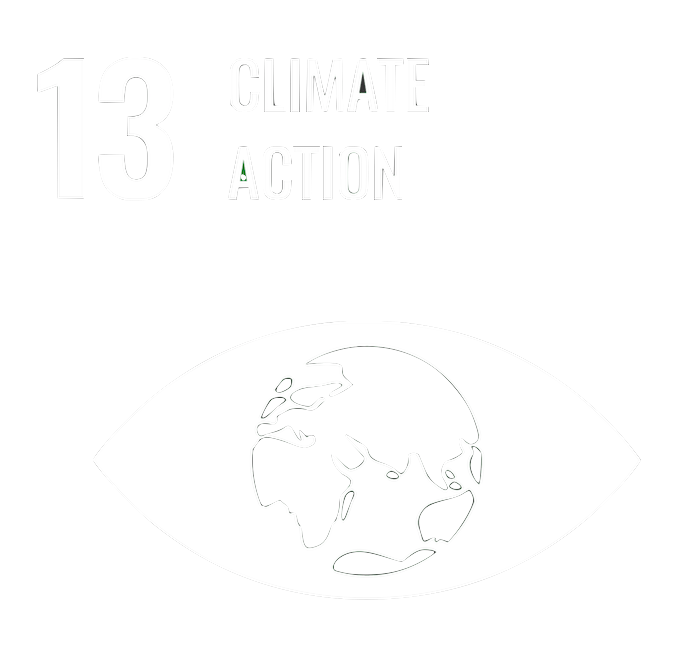
SDG 13: CLIMATE ACTION
Take urgent action to combat climate change and its impacts
What do we know?
Source: IOM, 2024.
Migration-relevant SDG targets and indicators:
Indicators below are classified by the IAEG-SDGs into three tiers based on their level of methodological development and the availability of data at global level, as outlined here:
Target 13.1: Strengthen resilience and adaptive capacity to climate-related disasters
Indicator 13.1.1 - Number of deaths, missing persons and directly affected persons attributed to disasters per 100,000 population
Migration relevance and rationale:
- Data can be disaggregated by migratory status.
- Reducing the risk of displacement due to climate change and natural disasters.
- Strengthening adaptation strategies and other mechanisms by which people can protect themselves from climate-related hazards that may cause displacement.
- Integrating migrants and migration into local and national strategies on climate change adaptation, environment and natural resource management, and disaster risk reduction and management. Improving responses to assist and protect environmental migrants and displaced communities.
Custodian agency: UNDRR
Data sources: IDMC
Examples of relevant, disaggregated datasets:
| Country/area | Dataset indicator | Last updated | Dataset link | Migration disaggregation |
|---|---|---|---|---|
| Global | Number of internal displacements in 2022 due to disaster | 2023 | IDMC | Internal displacement |
| Global | Total number of internally displaced persons (IDPs) due to disasters, as of Dec 2022 | 2023 | IDMC | Internally displaced persons |
If you know of additional data or data sources we should include here, please contact the team.
Target 13.2: Integrate climate change measures into policies and planning
Indicator 13.2.1 - Number of countries with nationally determined contributions, long-term strategies, national adaptation plans and adaptation communications, as reported to the secretariat of the United Nations Framework Convention on Climate Change
Migration relevance and rationale:
- Integrating displacement, migration and climate-related human mobility into local and national policies, strategies and planning on climate change adaptation, environment and natural resource management, and disaster risk reduction and management. Including climate change considerations into local and national policies, strategies and planning on migration management.
Custodian agency: UNFCCC
Data sources: tbc
Examples of relevant, disaggregated datasets:
| Country/area | Dataset indicator | Last updated | Dataset link | Migration disaggregation |
|---|---|---|---|---|
| Global | CLIMB Database of policy instruments containing provisions of relevance to human mobility in the context of disasters, the adverse effects of climate change, and environmental degradation. | 2023 | Migration Network Hub CLIMB Database | Relevant to human mobility |
If you know of data we should include here, please contact the team.
Target 13.3: Build knowledge and capacity to meet climate change
Migration relevance and rationale:
- Integrating displacement, migration and climate-related human mobility into local and national policies, strategies and planning on climate change adaptation, environment and natural resource management, and disaster risk reduction and management.
- Including climate change considerations into local and national policies, strategies and planning on migration management.
Datatier sources: tbc - if you know of data we should include here, please contact the team.
Target 13.b: Promote mechanisms to raise capacity for climate planning and management
Indicator 13.b.1 - Number of least developed countries and small island developing States that are receiving specialized support, and amount of support, including finance, technology and capacity-building, for mechanisms for raising capacities for effective climate change-related planning and management, including focusing on women, youth and local and marginalized communities.
Migration relevance and rationale:
- Addressing environment-related migration considerations in all climate change-related planning and management.
Custodian agency: UNFCCC
Data sources: tbc - if you know of data we should include here, please contact the team.
Sources:
Mosler Vidal, E. and F. Laczko, 2022. Migration and the SDGs: Measuring Progress – An Edited Volume. International Organization for Migration (IOM), Geneva.
IOM, 2018. Migration and the 2030 Agenda: Comprehensive SDG Target and Migration Correlation. International Organization for Migration (IOM), Geneva.
The Global Goals: Resources
Tiers updated according to:
2023, United Nations Statistical Commission, Inter-agency Expert Group on SDG Indicators Tier Classification for SDG indicators (as of 31 March 2023)
IAEG-SDGs Tier Classification for Global SDG Indicators
To facilitate the implementation of the global indicator framework, all indicators are classified by the IAEG-SDGs into three tiers based on their level of methodological development and the availability of data at the global level, as follows:
Source: 2023, United Nations Statistical Commission, Inter-agency Expert Group on SDG Indicators Tier Classification for SDG indicators (31 March 2023) and 13th meeting of the IAEG SDGs in November 2022.
SDG 14: LIFE BELOW WATER
Conserve and sustainably use the oceans, sea and marine resources for sustainable development
What do we know?
Migration-relevant SDG targets and indicators:
All indicators below are classified by the IAEG-SDGs into three tiers based on their level of methodological development and the availability of data at global level, as outlined here.
Target 14.2: Protect and restore ecosystems
Indicator 14.2.1: Number of countries using ecosystem-based approaches to managing marine areas
Migration relevance and rationale:
- Addressing forced displacement or migration of people due to marine and coastal ecosystem degradation.
- Increasing migrant and diaspora investments into initiatives addressing marine and coastal ecosystem sustainability.
Custodian agency: UNEP
Data sources: n/a - If you know of data we should include here, please contact the team.
Target 14.7: Increase the economic benefits from sustainable use of marine resources
Indicator 14.7.1: Sustainable fisheries as a proportion of GDP in small island developing States, least developed countries and all countries
Migration relevance and rationale:
- Improving and diversifying livelihoods of communities dependent on marine resources to address this as a potential driver of migration. Migrants (including returned migrants) could also potentially contribute to this by introducing new knowledge, skills and technology to communities.
Custodian agency: FAO, UNEP-WCMC
Data sources: n/a - If you know of data we should include here, please contact the team.
Sources:
IOM, 2018. Migration and the 2030 Agenda: Comprehensive SDG Target and Migration Correlation. International Organization for Migration (IOM), Geneva.
The Global Goals: Resources
Tiers updated according to: 2023, United Nations Statistical Commission, Inter-agency Expert Group on SDG Indicators Tier Classification for SDG indicators (31 March 2023)
Source: 2023, United Nations Statistical Commission, Inter-agency Expert Group on SDG Indicators Tier Classification for SDG indicators (31 March 2023) and 13th meeting of the IAEG SDGs in November 2022.
SDG 15: LIFE ON LAND
Protect, restore and promote sustainable use of terrestrial ecosystems, sustainably manage forests, combat desertification and halt and reverse land degradation and halt biodiversity loss.
What do we know?
Migration-relevant SDG targets and indicators
All indicators below are classified by the IAEG-SDGs into three tiers based on their level of methodological development and the availability of data at global level, as outlined here.
Target 15.3 End desertification and restore degraded land
Indicator 15.3.1 - Proportion of land that is degraded over total land area
Migration relevance and rationale:
- Addressing displacement or migration of people due to desertification and land degradation (DLD).
- Increasing migrant and diaspora investment into initiatives addressing DLD.
Custodian agency: UNCCD
Data sources:
- No data sources directly relating migration and land degradation.
If you know of data we should include here, please contact the team.
Sources:
IOM, 2018. Migration and the 2030 Agenda: Comprehensive SDG Target and Migration Correlation. International Organization for Migration (IOM), Geneva.
Migration for Sustainable Development, 2023. SDG 15: Data and Measuring Results. IOM.
The Global Goals: Resources
Tiers updated according to:
2023, United Nations Statistical Commission, Inter-agency Expert Group on SDG Indicators Tier Classification for SDG indicators (as of 31 March 2023)
Source: 2023, United Nations Statistical Commission, Inter-agency Expert Group on SDG Indicators Tier Classification for SDG indicators (31 March 2023) and 13th meeting of the IAEG SDGs in November 2022.
SDG 16: PEACE, JUSTICE AND STRONG INSTITUTIONS
Promote peaceful and inclusive societies for sustainable development, provide access to justice for all and build effective, accountable and inclusive institutions at all levels.
What do we know?
Source: IOM, 2024.
Migration-relevant SDG targets and indicators:
Indicators below are classified by the IAEG-SDGs into three tiers based on their level of methodological development and the availability of data at global level, as outlined here:
Target 16.1: Reduce violence everywhere
Indicator: 16.1.1 - Number of victims of intentional homicide per 100,000 population, by sex and age
Migration relevance and rationale:
- Data can be disaggregated by migratory status.
- Reducing all forms of violence that may target migrants, including due to xenophobia or racism, as well as reducing violence and death incidence throughout the migration cycle, including for migrants in countries of crisis and as part of addressing the drivers of migration and displacement.
Data sources:
- Criminal justice and public health/civil registration systems.
- Note: care needs to be taken for the migration variable to use the same definition in sources used.
If you know of data we should include here, please contact the team.
Indicator: 16.1.2 - Conflict-related deaths per 100,000 population, by sex, age and cause
Migration relevance and rationale:
- Data can be disaggregated by migratory status.
- Reducing all forms of violence that may target migrants, including due to xenophobia or racism, as well as reducing violence and death incidence throughout the migration cycle, including for migrants in countries of crisis and as part of addressing the drivers of migration and displacement.
Custodian agency: OHCHR
Data sources:
- Civil registration, hospital records, security forces, police and other law enforcement agencies, health authorities, international organizations, CSOs and others.
If you know of data we should include here, please contact the team.
Indicator: 16.1.3 - Proportion of population subjected to physical, psychological or sexual violence in the previous 12 months
Migration relevance and rationale:
- Data can be disaggregated by migratory status.
- Reducing all forms of psychological and sexual violence that may target migrants, including due to xenophobia or racism, as well as reducing violence and death incidence throughout the migration cycle, including for migrants in countries of crisis and as part of addressing the drivers of migration and displacement.
- One dimension that is always being mentioned is the domestic workers who are abused.
- Note: This indicator does not really distinguish by the type of perpetrators which is different from 5.2.1 and 5.2.2.
Custodian agency: UNODC
Data sources: Household surveys (see 5.2.1.)
Existing, relevant, disaggregated data:
| Country/area | Dataset indicator | Last updated | Dataset link | Migration disaggregation |
|---|---|---|---|---|
| Spain | Victims of gender-based violence by place of birth | 2021 | Instituto Nacional de Estadística | By place of birth: born in Spain, born outside Spain, Europe, Africa, America, Asia and Oceania |
If you know of data we should include here, please contact the team.
Indicator: 16.1.4 - Proportion of population that feel safe walking alone around the area they live after dark
Migration relevance and rationale:
- Data can be disaggregated by migratory status.
- Reducing all forms of violence that may target migrants, including due to xenophobia or racism, as well as reducing violence and death incidence throughout the migration cycle, including for migrants in countries of crisis and as part of addressing the drivers of migration and displacement.
Custodian agency: UNODC
Data sources: Victimization and other surveys.
Existing, relevant, disaggregated data:
| Country/area | Dataset indicator | Last updated | Dataset link | Migration disaggregation |
|---|---|---|---|---|
| Switzerland | Feeling of security by migration status | 2021 | Swiss Federal Statistical Office | By migration status |
| New Zealand | Proportion of migrants feeling safe/very safe walking alone in the neighborhood after dark, by migrant status and age group, in 2016–2017 | 2019 | Statistics New Zealand | By migrant status |
If you know of data we should include here, please contact the team.
Target 16.2: Protect children from abuse, exploitation, trafficking and violence
Indicator: 16.2.1 - Proportion of children aged 1–17 years who experienced any physical punishment and/or psychological aggression by caregivers in the past month
Migration relevance and rationale:
- Data can be disaggregated by migratory status.
- Combatting all forms of trafficking of children.
- Addressing vulnerability and protecting the rights, well-being and interests of child migrants throughout the migration cycle, for example addressing the detention of migrant children, assisting unaccompanied migrant children.
Custodian agency: UNICEF
Data sources: Household surveys (e.g. MICS and DHS)
If you know of data we should include here, please contact the team.
Indicator: 16.2.2 - Number of victims of human trafficking per 100,000 population, by sex, age and form of exploitation
Migration relevance and rationale:
- Combatting all forms of trafficking of children.
- Addressing vulnerability and protecting the rights, well-being and interests of child migrants throughout the migration cycle, for example addressing the detention of migrant children, assisting unaccompanied migrant children.
Custodian agency: UNODC
Data sources:
- Data sources on detected cases include administrative records from criminal justice and other official sources such as police, social services, immigration and asylum, and border-control agencies.
- Available data focuses on detected rather than undetected cases of trafficking in persons, meaning this is an underestimate.
Existing, relevant, disaggregated datasets:
| Country/area | Dataset indicator | Last updated | Dataset link |
|---|---|---|---|
| Niger |
Victimes de traite des personnes |
2020 | Les données sur la migration au Niger |
| South Africa | Incidence of human trafficking for sexual purposes brought to police attention | 2018 | Goal Tracker South Africa |
| Global |
Proportion of children among victims of trafficking identified by CTDC partners (by country of exploitation) |
2002 – 2021 | CTDC |
| Global | Proportion of women among victims of trafficking identified by CTDC partners (by country of citizenship), 2002 – 2021 | 2002-2021 | CTDC |
If you know of data we should include here, please contact the team.
Indicator 16.2.3 - Proportion of young women and men aged 18–29 years who experienced sexual violence by age 18
Migration relevance and rationale:
- Data can be disaggregated by migratory status.
- Combatting all forms of trafficking of children. Addressing vulnerability and protecting the rights, well-being and interests of child migrants throughout the migration cycle, for example addressing the detention of migrant children, assisting unaccompanied migrant children.
Custodian agency: UNICEF
Data sources: Household surveys (e.g. MICS and DHS) (as 16.2.1)
If you know of data we should include here, please contact the team.
Target 16.3: Promote the rule of law and ensure equal access to justice for all
Indicator: 16.3.1 - Proportion of victims of violence in the previous 12 months who reported their victimization to competent authorities or other officially recognized conflict resolution mechanisms
Migration relevance and rationale:
- Data can be disaggregated by migratory status.
- Improving access to justice, due process and equal legal treatment to address the needs and human rights of all migrant groups, including migrant workers, irregular migrants, victims of trafficking, asylum seekers and refugees, and as part of addressing the drivers of migration and displacement.
- Regulating and monitoring migrant detention practices to comply with international law and standards, taking extra care to monitor and eradicate the detention of migrant minors.
Custodian agency: UNODC
Data sources:
- Include victimization and other surveys, penitentiary and criminal justice records, and other data on intentional homicide. If disaggregated, this can monitor migrants’ trust and confidence in authorities. If surveys are used, it will be difficult to produce disaggregated, representative data.
If you know of data we should include here, please contact the team.
Indicator: 16.3.2 - Unsentenced detainees as a proportion of overall prison population
Migration relevance and rationale:
- Data can be disaggregated by migratory status.
- Improving access to justice, due process and equal legal treatment to address the needs and human rights of all migrant groups, including migrant workers, irregular migrants, victims of trafficking, asylum seekers and refugees, and as part of addressing the drivers of migration and displacement.
- Regulating and monitoring migrant detention practices to comply with international law and standards, taking extra care to monitor and eradicate the detention of migrant minors.
Custodian agency: UNODC
Data sources:
- Data sources include prison records. This can help monitor immigration detention (although access to facilities may be restricted) and could also be disaggregated by length of unsentenced detention.
If you know of data we should include here, please contact the team.
Indicator: 16.3.3 - Proportion of the population who have experienced a dispute in the past two years and who accessed a formal or informal dispute resolution mechanism, by type of mechanism
Migration relevance and rationale:
- Data can be disaggregated by migratory status.
- Improving access to justice, due process and equal legal treatment to address the needs and human rights of all migrant groups, including migrant workers, irregular migrants, victims of trafficking, asylum seekers and refugees, and as part of addressing the drivers of migration and displacement.
- Regulating and monitoring migrant detention practices to comply with international law and standards, taking extra care to monitor and eradicate the detention of migrant minors.
Custodian agency: UNDP, OECD, UNODC
Data sources:
- Data sources include household surveys. This can help monitor migrants’ access to justice.
- Disaggregation by type of mechanism can help assess the type of justice institutions and mechanisms available for migrants.
If you know of data we should include here, please contact the team.
Target 16.4: Combat organized crime and illicit financial and arms flows
Migration relevance and rationale: Tackling organized crime linked to smuggling, trafficking and the flow of forged identity and travel documents.
Data sources: tbc - if you know of data we should include here, please contact the team.
Target 16.6: Develop effective, accountable and transparent institutions
Migration relevance and rationale: Ensuring all migration or migration-related ministries and authorities, institutions and systems are accountable and transparent at all levels.
Data sources: tbc - if you know of data we should include here, please contact the team.
Target 16.7: Ensure responsive, inclusive and representative decision-making
Indicator 16.7.1 - Proportions of positions in national and local institutions, including (a) the legislatures; (b) the public service; and (c) the judiciary, compared to national distributions, by sex, age, persons with disabilities and population groups
Migration relevance and rationale:
- Data can be disaggregated by migratory status.
- Participatory approaches that include migrants should be encouraged; all types of migrants should be proactively included in as many aspects of decision-making as possible related to migration and development.
Data sources:
- Records from national parliaments, public institutions and national judiciary systems.
- Metadata recommends disaggregating by nationally relevant population groups (groups with a distinct ethnicity, language, religion, indigenous status, nationality or other characteristics).
If you know of data we should include here, please contact the team.
Indicator 16.7.2 - Proportion of population who believe decision-making is inclusive and responsive, by sex, age, disability and population group
Migration relevance and rationale:
- Data can be disaggregated by migratory status.
- Participatory approaches that include migrants should be encouraged; all types of migrants should be proactively included in as many aspects of decision-making as possible related to migration and development.
Custodian agency: UNDP
Data sources:
- Household surveys. Metadata recommends disaggregating by nationally relevant population groups.
- Note: When using internationally recommended survey questions, high-quality translation into various languages as well as appropriate enumerator training are needed, given this includes the idiom “to have a say”, which has different meanings in different languages.
If you know of data we should include here, please contact the team.
Target 16.9: Provide universal legal identity
Indicator: 16.9.1 - Proportion of children under 5 years of age whose births have been registered with a civil authority, by age
Migration relevance and rationale:
- Data can be disaggregated by migratory status.
- Ensuring all migrant groups, particularly migrants’ children, are provided with the legal identity they are entitled to, helping eradicate statelessness and also facilitating access to health care, social protection, education and citizenship or permanent residence applications.
Custodian agency: UNSD, UNICEF
Data sources:
- Civil registration, household surveys, censuses.
- Note: Disaggregation by maternal migratory status could be useful.
Existing, relevant, disaggregated datasets:
| Country/area | Dataset indicator | Last updated | Dataset link | Migration disaggregation |
|---|---|---|---|---|
| United Kingdom |
Births by parents' country of birth, England and Wales |
2021 | UK Office of National Statistics | Parents' country of birth |
If you know of data we should include here, please contact the team.
Target 16.B: Promote and enforce non-discriminatory laws and policies
Indicator 16.b.1 - Proportion of population reporting having personally felt discriminated against or harassed in the previous 12 months on the basis of a ground of discrimination prohibited under international human rights law
Migration relevance and rationale:
- Data can be disaggregated by migratory status.
- Proactively considering minorities and all types of migrants in non-discriminatory laws and policies.
Custodian agency: OHCHR
Data sources: see 10.3.1.
Existing, relevant, disaggregated data sources:
| Country/area | Dataset indicator | Last updated | Dataset link | Migration disaggregation |
|---|---|---|---|---|
| Switzerland |
Experience of racial discrimination by migration status |
2022 | Swiss Confederation | Population with and without migration background |
| Belarus | Percentage of women and men aged 15–49 who in the last 12 months have felt discriminated or harassed on selected grounds | 2019 | National Statistical Committee of the Republic of Belarus and UNICEF | Selected grounds includes: Ethnic or immigration origin |
| Central African Republic; Chad; Democratic Republic of the Congo; Lesotho; Tunisia; Zimbabwe | Proportion of population reporting having felt discriminated against, by grounds of discrimination, sex and disability/Persons without disability/Ethnicity, colour, langauge/Both sexes (%) | 2019 - Central African Republic; Chad; Zimbabwe 2018 - Democratic Republic of the Congo; Lesotho; Tunisia; |
ECASTATS | Discrimination for ethnicity |
| Trinidad and Tobago | Percentage of women who in the last 12 months have felt discriminated against or harassed on the basis of ethnic or immigration origin | 2022 | MICS, UNICEF | on the basis of ethnic or immigration origin |
| Eswatini | Percentage [of men and women] age 15-49 years who in the past 12 months have felt discriminated against or harassed and those who have not felt discriminated against or harassed on the basis of ethnic or immigration origin | 2021-2022 | MICS, UNICEF | on the basis of ethnic or immigration origin |
| Uzbekistan | Percentage of women who in the last 12 months have felt discriminated against or harassed on the basis of ethnic or immigration origin | 2021-2022 | MICS UNICEF | on the basis of ethnic or immigration origin |
| Malawi | Percentage [of men and women] age 15-49 years who in the past 12 months have felt discriminated against or harassed and those who have not felt discriminated against or harassed on the basis of ethnic or immigration origin | 2019-2020 | MICS UNICEF | on the basis of ethnic or immigration origin |
If you know of data we should include here, please contact the team.
Sources:
Mosler Vidal, E. and F. Laczko, 2022. Migration and the SDGs: Measuring Progress – An Edited Volume. International Organization for Migration (IOM), Geneva.
Mosler Vidal, E., 2021. Leave No Migrant Behind: The 2030 Agenda and Data Disaggregation. International Organization for Migration (IOM), Geneva.
IOM, 2018. Migration and the 2030 Agenda: Comprehensive SDG Target and Migration Correlation. International Organization for Migration (IOM), Geneva.
United Nations Statistics Division, Improving migration data in the context of the 2030 Agenda, 15 June 2017
The Global Goals: Resources
Tiers updated according to:
2023, United Nations Statistical Commission, Inter-agency Expert Group on SDG Indicators Tier Classification for SDG indicators (as of 31 March 2023)
IAEG-SDGs Tier Classification for Global SDG Indicators
To facilitate the implementation of the global indicator framework, all indicators are classified by the IAEG-SDGs into three tiers based on their level of methodological development and the availability of data at the global level, as follows:
Tier 1:Indicator is conceptually clear, has an internationally established methodology and standards are available, and data are regularly produced by countries for at least 50 per cent of countries and of the population in every region where the indicator is relevant.
Source: 2023, United Nations Statistical Commission, Inter-agency Expert Group on SDG Indicators Tier Classification for SDG indicators (31 March 2023) and 13th meeting of the IAEG SDGs in November 2022.
SDG 17: PARTNERSHIPS FOR THE GOALS
Strengthen the means of implementation and revitalize the global partnership for sustainable development
Note: Target 17.18 explicitly mentions data disaggregated by migratory status
What do we know?
Migration-relevant SDG targets and indicators:
Indicators below are classified by the IAEG-SDGs into three tiers based on their level of methodological development and the availability of data at global level, as outlined here:
Target 17.3 Mobilize financial resources for developing countries
Indicator: 17.3.2 Volume of remittances (in United States dollars) as a proportion of total GDP
Migration relevance and rationale:
- Mobilizing all migration-related financial resources as appropriate, including remittance flows and diaspora investment.
Custodian agency: World Bank
Data sources: tbc
Examples of existing, relevant datasets:
| Country/area | Dataset indicator | Last updated | Dataset link |
|---|---|---|---|
| Global | Cost of sending and receiving money (remittances) between countries | 2023 | World Bank |
| Africa (can be further disaggregated by region and country groupings) | Volume of remittances (in US dollars) as a proportion of total GDP (%) | 2020 | ECASTATS |
If you know of data we should include here, please contact the team.
Target 17.5: Invest in least developed countries
Migration relevance and rationale:
- Leveraging the investment potential of diaspora communities.
Data sources: tbc - if you know of data we should include here, please contact the team.
Target 17.9: Enhance SDG capacity in developing countries
Migration relevance and rationale:
- Participating in international dialogue and capacity-building on migration governance at local, national, regional and international levels, including cooperating on topics such as bilateral agreements and return migration.
- Engaging in efforts to mainstream migration into development policy and programmes that build capacities of governments to more effectively manage migration.
Data sources: tbc - if you know of data we should include here, please contact the team.
Target 17.13: Enhance global macroeconomic stability
Migration relevance and rationale:
- Using, where appropriate, remittance flows, diaspora investment and foreign exchange to help achieve macroeconomic stability.
Data sources: tbc - if you know of data we should include here, please contact the team.
Target 17.14: Enhance policy coherence for sustainable development
Migration relevance and rationale:
- Enhancing vertical and horizontal policy coherence in all areas of migration governance and migration interventions and activities.
- Encouraging the practice of migration mainstreaming in development planning.
Data sources: tbc - if you know of data we should include here, please contact the team.
Target 17.16 Enhance the global partnership for sustainable development
Migration relevance and rationale:
- Building and strengthening multi-stakeholder partnerships between international organizations, governments, civil society, private sector and others to improve migration governance and address cross-cutting migration issues, for example ethical recruitment, migrant health and cross-border health collaboration, and migration, environment and climate change linkages.
- Strengthening the capacity of migrants themselves to be development partners.
Data sources: tbc - if you know of data we should include here, please contact the team.
Target 17.17: Encourage effective partnerships
Migration relevance and rationale:
- Building and strengthening public, public–private and civil society partnerships to improve migration governance and address cross-cutting migration issues, and mobilizing resources this way.
Data sources: tbc - if you know of data we should include here, please contact the team.
Target 17.18: Enhance availability of reliable data... [migratory status]
"By 2020, enhance capacity-building support to developing countries, including for least developed countries and small island developing States, to increase significantly the availability of high-quality, timely and reliable data disaggregated by income, gender, age, race, ethnicity, migratory status, disability, geographic location and other characteristics relevant in national contexts"
Indicator: 17.18.1 - Proportion of sustainable development indicators produced at the national level with full disaggregation when relevant to the target, in accordance with the Fundamental Principles of Official Statistics.
Migration relevance and rationale:
- Strengthening systems and processes around migration data collection, exchange, monitoring, analysing and reporting at all levels of government as well as with other actors, for example publishing data on a regular basis on migration-related topics, monitoring implementation of local and national legislation and policies on migration.
- Building local and national capacity to improve migration data in the future, for example training researchers, statisticians and research institutions to research and monitor migration topics. Improving collection and disaggregation of development and other types of data (for example in education and health) by migration-related variables such as migratory status.
Custodian agency: n/a.
Data sources: tbc - if you know of data we should include here, please contact the team.
Indicator: 17.18.2 - Number of countries that have national statistical legislation that complies with the Fundamental Principles of Official Statistics.
Migration relevance and rationale: [see 17.18.1]
Data sources: tbc if you know of data we should include here, please contact the team.
Indicator: 17.18.3 - Number of countries with a national statistical plan that is fully funded and under implementation, by source of funding.
Migration relevance and rationale: [see 17.18.1]
Custodian agency: PARIS21
Data sources: tbc - if you know of data we should include here, please contact the team.
Target 17.19: Further develop measurements of progress
Migration relevance and rationale: Strengthening statistical systems and processes around migration data. Supporting statistical and all migration data-related capacity-building for developing countries.
Data sources: tbc - if you know of data we should include here, please contact the team.
Sources:
IOM, 2018. Migration and the 2030 Agenda: Comprehensive SDG Target and Migration Correlation. International Organization for Migration (IOM), Geneva.
Migration for Sustainable Development, 2023. SDG 17: Data and Measuring Results. IOM.
IOM, 2018. Migration and the 2030 Agenda: Comprehensive SDG Target and Migration Correlation. International Organization for Migration (IOM), Geneva.
The Global Goals: Resources
Tiers updated according to:
2023, United Nations Statistical Commission, Inter-agency Expert Group on SDG Indicators Tier Classification for SDG indicators (as of 31 March 2023)
IAEG-SDGs Tier Classification for Global SDG Indicators
